



ISSUE 1514 MAY 6TH '23 ג"פשת רייא ו"ט PARSHAT EMOR AVOT CHAPTER 4 ה"ב רומא תשרפ OU ISRAEL 02-560-9100 | TorahTidbits.com | ADVERTISING 02- 560-9125 YERUSHALAYIM IN/OUT TIMES FOR SHABBAT PARSHAT EMOR CANDLES 6:46PM • EARLIEST 5:57PM • HAVDALA 8:02PM • RABBEINU TAM 8:40PM Simchat Shmuel Rabbi Sam Shor Program Director, OU Israel Center page 48 OU Israel Parenting Column Michal Silverstein, MS page 70 Wishing You Lag Baomer Sameach! ךירשא תחשמנ יאחוי רב ךירבחמ ןושש ןמש
Table of Contents
04
08
12
18
22
28
Dear Torah Tidbits Family
Rabbi Avi Berman
Emor and Lag B’Omer – Merging Heaven and Earth Rabbi Moshe Hauer
Aliya By Aliya Sedra Summary
Rabbi Reuven Tradburks
Becoming a Kohen
Rabbi Dr. Tzvi Hersh Weinreb
Holy Times
Rabbi Lord Jonathan Sacks zt"l
Probing The Prophets
Rabbi Nachman Winkler
30Unique Aspect of Shavuot
Rabbi Shalom Rosner
34Lessons of the Land
Rebbetzin Shira Smiles
36Pesach Sheini: Again, From Close
Rabbi Judah Mischel
48
Simchat Shmuel
Rabbi Sam Shor
50Blood Libels and the Perversion of Jewish Values Rabbi Moshe Taragin
Helpful Reminders
54Relocating Synagogues to the Land of Israel
Rabbi Aaron Goldscheider
58Haftorah Insights
Rebbetzin Dr. Adina Shmidman
60Removing Dirt from a Sefer Torah on Shabbat
Rabbi Daniel Mann
62Chadash Prohibition in Israel #2
Rabbi Moshe Bloom
63International Bible Quiz Champions Speak
Sivan Rahav Meir
64Miraculous Birth
Rabbi Gideon Weitzman
66Creating 'New' Jewish Holidays
Rabbi Shimshon HaKohen Nadel
68From the Ha'emek Davar - Emor Dr. Jacob Solomon
70OU Israel Parenting Column
Michal Silverstein
72The Y- Files Weekly Comic Netanel Epstein
74OU-JLIC Rabbi Joe Wolfson
76Torah 4 Teens By Teens
Rena Bessner // Eli Dersovitz
Lag BaOmer is observed on Monday night May 8th and Tuesday May 9th

This week's Torah Tidbits cover image!
Photo taken by Shlomo Gherman
Made Aliyah from Long Island NY to Jerusalem
What the photo means to me: The photo was taken in Mea Shaarim in a little courtyard that reminded me of the shtetels of Eastern Europe. For the chassidim it is not just a bonfire but something that has deep religious significance. The atmosphere also lends itself to some very dynamic photographic opportunities.
2 TORAH TIDBITS 1514 / EMOR
AND HAVDALA TIMES
OTHER Z'MANIM
JERUSALEM
Ranges 11 days Wed - Shabbat
May 3-13 / 12-22 Iyar

Earliest Tallit and Tefillin
4:58 - 4:48
Sunrise 5:52 - 5:44
Sof Zman Kriat Shema 9:14 - 9:10
Magen Avraham 8:34 - 8:29
Sof Zman Tefila 10:21 - 10:18
(According to the Gra and Baal HaTanya)
Chatzot (Halachic Noon) 12:36 - 12:35
Mincha Gedola (Earliest Mincha) 1:10
Plag Mincha
5:56 - 6:01
Sunset (Including Elevation) 7:25 - 7:32
Seymour J. Abrams • Orthodox Union Jerusalem World Center • Avrom Silver Jerusalem College for Adults • Wolinetz Family Shul • Makom BaLev • Birthright • Yachad • NCSY in Israel • JLIC in Israel • Camp Dror • Pearl & Harold M. Jacobs ZULA Outreach Center • The Jack Gindi Oraita Program • OU Israel Kashrut
STUART HERSHKOWITZ, PRESIDENT OU ISRAEL
Zvi Sand / Yitzchak Fund: Former Presidents, OU Israel

| Rabbi Emanuel Quint z”l, Senior Vice President | Prof. Meni Koslowsky, Vice President
VAAD MEMBERS:
Michael Elman | Yonatan Frankel | Yitchak Fund | Daniella Hellerstein | Stuart Hershkowitz | Jeremy Lustman | Meir Raskas | Atara Reichel | Zvi Sand | Norman Schmutter | Mark Schneider | Esther Williams
RABBI AVI BERMAN, EXECUTIVE DIRECTOR, OU ISRAEL
Times According to MyZmanim (20 min. before sundown in most cities, 40 min. in Yerushalyim and Petach Tikva, 30 min. in Tzfat/Haifa)
OU Kashrut NCSY Jewish Action JLIC NJCD / Yachad / Our Way OU West Coast OU Press Synagogue/Community Services OU Advocacy OU Israel
MITCHEL R. AEDER, PRESIDENT OF THE ORTHODOX UNION Yehuda Neuberger, Chairman of the Board, Orthodox Union | Dr. Josh Penn, OU Kashrus Commission

RABBI MOSHE HAUER, EXECUTIVE VICE PRESIDENT | RABBI JOSHUA M. JOSEPH, ED.D. EXECUTIVE VICE PRESIDENT & CHIEF OPERATING OFFICER
Rabbi Dr. Tzvi Hersh Weinreb, Exec. V.P. Emeritus
OU KOSHER: Rabbi Menachem Genack, CEO/Rabbinic Administrator OU Kosher | Rabbi Moshe Elefant, COO/Executive Rabbinic Coordinator ISRAEL: Rabbi Yissachar Dov Krakowski, Rabbinic Administrator | Rabbi Ezra Friedman, The Gustave and Carol Jacobs Center for Kashrut Education/ Deputy Rabbinic Administrator
Headquarters: 40 Rector St. 4th floor, New York, NY 10006 212-563-4000 website: www.ou.org
Editor Emeritus: Phil Chernofsky
Editor: Rabbi Aaron Goldscheider | aarong@ouisrael.org
Advertising: Ita Rochel | 02-5609125 or ttads@ouisrael.org
Website: www.torahtidbits.com
Not getting enough TTs? Too many? None at all?
Contact our DISTRIBUTION 050-577-2111 • ttdist@ouisrael.org
David Katz, CFO, OU Israel | Chaim Pelzner, Director of Programs, OU Israel | Rabbi Sam Shor, Director of Programs, OU Israel Center Rabbi Sholom Gold, Dean, Avrom Silver Jerusalem College for Adults
22 Keren HaYesod <> POB 1441 <> Jerusalem
9101032
phone: (02) 560 9100 | fax: (02) 561-7432
email: office@ouisrael.org
website: www.ouisrael.org
Founders and initial benefactors of the OU Israel Center: George and Ilse Falk a"h
Torah Tidbits and many of the projects of OU Israel are assisted by grants from THE JERUSALEM MUNICIPALITY
OU Israel, Torah Tidbits does not endorse the political or halachic positions of its editor, columnists or advertisers, nor guarantee the quality of advertised services or products. Nor do we endorse the kashrut of hotels, restaurants, caterers or food products that are advertised in TT (except, of course, those under OU-Israel hashgacha). Any "promises" made in ads are the sole responsibility of the advertisers and not that of OU Israel, the OU Israel Center , Torah Tidbits.
OU ISRAEL CENTER 3
CANDLE LIGHTING
BEHAR-BECHUKOTAI HAVDALA EMOR EARLY CANDLES Havdala Early Candles 8:02 Yerushalayim / Maale Adumim 5:57 6:46 8:08 6:01 6:51 8:10 6:03 7:08 8:04 Aza area (Netivot, S’derot, Et al) 5:59 7:03 8:09 6:02 7:10 8:03 Beit Shemesh / RBS 5:58 7:05 8:08 6:01 7:06 8:02 Gush Etzion 5:57 7:01 8:10 6:03 7:08 8:04 Raanana/ Tel Mond/ Herzliya/ K. Saba 5:59 7:03 8:09 6:02 7:07 8:03 Modi’in / Chashmona’im 5:58 7:02 8:11 6:03 7:09 8:05 Netanya 5:59 7:04 8:08 6:02 7:07 8:03 Be’er Sheva 5:58 7:02 8:10 6:03 7:08 8:04 Rehovot 5:59 7:03 8:10 6:03 6:51 8:04 Petach Tikva 5:59 6:46 8:09 6:02 7:07 8:04 Ginot Shomron 5:58 7:02 8:11 6:04 6:59 8:06 Haifa / Zichron 6:00 6:54 8:08 6:01 7:06 8:02 Gush Shiloh 5:57 7:01 8:10 6:03 7:08 8:05 Tel Aviv / Giv’at Shmuel 5:59 7:03 8:08 6:01 7:11 8:03 Giv’at Ze’ev 5:57 7:06 8:08 6:01 7:06 8:02 Chevron / Kiryat Arba 5:57 7:01 8:10 6:03 7:09 8:05 Ashkelon 6:00 7:04 8:09 6:03 7:08 8:04 Yad Binyamin 5:59 7:03 8:10 6:01 7:03 8:04 Tzfat / Bik’at HaYarden 5:57 6:57 8:09 6:01 7:06 8:03 Golan 5:57 7:01 Rabbeinu Tam (J'lem) - 8:40PM • next week - 8:45pm Daf Yomi this Shabbat: Sota 38
DEAR TORAH TIDBITS FAMILY
RABBI AVI BERMAN Executive Director, OU Israel
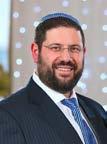
One thing I see at the meetings I go to is that the OU is committed to supporting the Orthodox and broader Jewish community around the world. One of the key areas of focus for so many OU programs is providing the community with opportunities to feel passionate about their Judaism. We do this through NCSY Shabbatonim, Camp Dror, Israel Free Spirit, OU-JLIC and so many more programs. The staff of these programs are with the youth and see their inspiration first-hand. This Yom HaZikaron and Yom HaAtzmaut provided me and thousands of my brothers and sisters with opportunities to tap into this passion with the OU. It enabled so many adults to see the passion of our youth which most of us don’t have the opportunity to experience on a regular basis.
Yom HaZikaron: A Day of International Unity
To give Jews from around the world a taste of the power of Yom HaZikaron, OneFamily Fund and the Center for Religious Affairs in the Diaspora hosted 1,500 visitors spanning 50 countries at Binyanei Hauma. The event welcomed families who had lost loved ones, including Rabbi Leo Dee, Miriam Peretz, Racheli Fraenkel and Renana Meir, who shared their stories and offered words of hope. It was an emotional yet inspiring experience for those present. My wife joined me at the event and we were
grateful for the tremendous efforts made to help Jews of the Diaspora feel connected to the reality of Am Yisrael living in Eretz Yisrael.
The next day, OU Israel had the Zechut of taking OU leadership including Mr. Mitch Aeder (OU President), Rabbi Moshe Hauer (EVP), Rabbi Dr. Josh Joseph (EVP and COO), Mr. Stuart Hershkowitz (OU Israel President), board members, and other chasuv individuals to Gush Etzion. We started the day at Yeshivat Har Etzion with Shacharit and a library tour led by Rabbi Moshe Taragin which focused on the fallen IDF soldiers who learned in the Yeshiva. Following the tour we went to the rooftop of the Yeshiva, and heard from the mayor of Gush Etzion, Rabbi Shlomo Ne’eman, who explained the view – the path our forefathers walked on and Eretz Yisrael being built up.
From the Yeshiva, we went to the historic
4 TORAH TIDBITS 1514 / EMOR
The OU Israel Family sends deepfelt condolences to Dr. Lita & Mitchel R. Aeder and family
(President of the OU's Board of Directors) on the passing of her father
םילשוריו ןויצ ילבא ראש ךותב םכתא םחני םוקמה
Dr. Jaime Sznajder z"l
Gush Etzion cemetery where Lucy, Maia and Rina Dee were most recently buried beside countless others who were killed in terror attacks or fell in battle. Rabbi Taragin and I hosted a live broadcast of the official Yom HaZikaron commemoration, during which we provided English narration and commentary for viewers around the world. We interviewed Hillel Fuld, the brother of Ari Fuld Hy”d, and Rabbi Leo Dee. (You can view the broadcast on OU Israel’s YouTube channel.)
Leil HaAtzmaut Tefila Chagigit – Inspiration from Yerushalayim










Ending the sobering day with OU Israel’s Leil HaAtzmaut program led by Rabbi Shlomo Katz was deeply meaningful. For the first time, OU Israel hosted our Leil HaAtzmaut Tefila Chagigit in the larger Gan Hapaamon to make room for a crowd of over 5,000 people. We were fortunate to be joined by Mr. Mitch Aeder, Rabbi Moshe Hauer, Rabbi Dr. Josh Joseph, Rabbi Menachem Genack, Rabbi Hershel Shachter, Mr. Stuart Hershkowitz, and Iriyat Yerushalayim representatives including Arieh King, Deputy Mayor of Yerushalayim. The event, which began with Maariv, was followed by a beautiful Tefila Chagigit that had the crowd singing in a unified voice that could be heard throughout the streets of Baka and Katamon, and dancing as one.
Following the event I connected with my colleagues to hear their thoughts. Each colleague reflected upon the same idea: the crowd of 5,000+ individuals was made up of mostly teenagers and young adults, each of whom danced passionately and joyously. I know I speak for thousands of attendees when I say we felt a spiritual high dancing
OU ISRAEL CENTER 5 True
Engagement Rings ∙ Stud Earrings Pendants ∙ Tennis Bracelets 050-573-9061 jeffmor36@gmail.com www.JeffMorDiamondJewelry.com
wholesaler from the diamond boursa with over 25 years experience member diamond dealers club
and celebrating the miracle of the State of Israel. You can view a highlights clip on OU Israel’s YouTube channel.
Yom HaAtzmaut: Chidon HaTanach & Barbeques
On the morning of Yom HaAtzmaut I was privileged to invite and be joined by OU leadership at Yeshivat Merkaz HaRav for Shacharit and dancing with my sons who are learning there. Once again, I was touched by the fervent dancing and singing of the students.
From there, as we do every year, my wife and I sat down with our children to watch the Chidon HaTanach and were moved to see so many children engaged in Tanach, excited about their history and passionate about our shared destiny in Eretz Yisrael.
We ended the day fulfilling what many consider the “Mitzvah” of the day with a barbeque with friends.
How will we inspire the younger generation to feel passionate about Am Yisrael and our collective destiny? After the Yom HaZikaron and Yom HaAtzmaut experiences I had, I believe we are seeing the bright future of Klal Yisrael unfold. May we continue to be successful in our efforts to inspire future generations of Am Yisrael.
I look forward to seeing everyone on Friday morning, May 19, for OU Israel’s Yom Yerushalayim Tefila Chagigit taking place at the Tayelet, Haas Promenade, in Armon Hanatziv. The Tefila will be led by Rabbi Noam Koeningsberg.


Wishing you all an uplifting and inspiring Shabbat, Rabbi Avi Berman Executive Director, OU Israel aberman@ouisrael.org

In loving memory of our beloved mother and bubby
Evelyn Weindling a"h
May the Torah learning from this issue be תמשנ יוליעל ה"ע השמ םהרבא תב לתע הוח on her 8th yahrtzeit - רייא ז"ט
Greatly missed by her children and grandchildren
Marsha, Melissa, and Becky Pottash
Steven and Lizzie Weindling and Nan Abbot
Shoshanah-Ruth, Naftalia Maya, and Yaira Rachel Weindling and Lee DiTullio
6 TORAH TIDBITS 1514 / EMOR
but you could possibly do them. For when it comes to communications from G-d, you are unique, irreplaceable, sui generis, one of a kind.
This exchange presents a fundamental principle of the Torah: that G-d speaks to Moshe in a way that He does not, nor will He in the future ever do again with anyone else. When Moshe says that people come to him seeking G-d, what he means is: I have access to G-d. He speaks to me. (Speaking to G-d isn’t the trick; the trick is when He answers back.) Similarly, when Moshe says that he teaches G-d’s law, what he means is that G-d communicates those laws to him and to no one else.
This could very well be the prime purpose of this Yitro story. For, in the very next story, the giving of the Torah, the very same theme of Moshe’s uniqueness as the one to whom G-d speaks is central.
3 aliya (18:24-27) Moshe heard. He chose judges, with only the most difficult cases brought to him. Moshe sent Yitro home.


It takes an honest leader to accept suggestions to improve. Moshe displays his honesty and humility – if the suggestion is good, embrace it. Just as Yitro accepted the news of the Exodus and affirmed One G-d,



kerenmalki.org

02-567-0602

Keren Malki empowers families of children with special needs in Israel to choose home care. Donations are tax-approved in Israel, US and UK.


Honoring the memory of Malka Chana Roth ד”יה 1985-2001, killed in the Sbarro bombing.

OU ISRAEL CENTER 7
MarSea Modest Swim & Casualwear www.MarSeaModest.net (NIS) www.MarSeaModest.com ($USD) Marci Rapp 050-424-8359 THE BEST DESIGN, ENGINEERING AND INSTALLATION OF AIR davidz@AshkelonProperties.com LIVE OPPOSITE THE SEA 0544-332621 said another happy client Ashkelon for only 15% down – is actually a reality.” Owning your own apartment does not just allow you freedom, but offers monetary savings, and an increase in your investment value. Anglo-populated, sunny Ashkelon is the answer! It’s very affordable – from $500,000 with just a 15% down payment, mortgages available as well as bank guarantees. Rental income often in excess of 3.5%. LIVE OPPOSITE THE SEA davidz@AshkelonProperties.com call David at 054-433-2621 www.ashkelonproperties.com C o n t a c t u s f o r t h e l a r g e s t s e l e c t i o n o f s e a - v i e w p r o p e r t i e s f o r s a l e o r r e n t Join our 107 happy Anglo customers who bought at our special prices. “Sails” of Sea view Ashkelon properties are soaring… “don't miss the boat”! Ashkelon MASSAGE THERAPIST & FITNESS TRAINER 052.673.3704 I www.andyhealth.com | jerusalemmyhome@hotmail.com TUVIA ANDY HAAS BALANCE and FALL-PREVENTION SPECIALIST for OLDER ADULTS Maintain Healthy Bones and Muscles Decrease Stiffness and Joint Pain Increase Strength! Stay Independent!
OU Executive Vice President

Emor and Lag B’Omer –Merging Heaven and Earth
While in other faiths the men of the cloth preside over death and dying by administering last rites, the priestly class of Klal Yisrael – the kohanim - were to avoid even being in the same room as the dead and dying.
The task of the kohein follows the path of Aaron, the original kohein gadol, who loved and pursued peace (Avos 1:12; Avos d’Rabbi Natan 12:3). Everything Aaron did was focused on creating harmony and wholeness, whether outside the mikdash where he sought to reconcile and bring together people who had been feuding, or inside the mikdash where he brought the people closer to G-d and the physical closer to the divine. The focus on harmony and wholeness is the reason that the altar could not be made of cut stones, as the altar is a vehicle for connection that cannot be formed with a tool that divides and destroys (Shemos 20:22; Rashi). The term korban, the Hebrew word for an offering, though often

translated as sacrifice, actually relates to its root karov, ‘close’, as the offering is a vehicle through which the physical and the spiritual worlds are brought together, offering the earthy animal on the altar of ascent to the heavenly G-d.
Death is therefore not the place for Aaron and his sons. Death is the ultimate moment of separation, where the body returns to the earth and the soul to its maker. The kohein – tasked with bringing everything together – has no place at that moment of the ultimate separation.
This goal of forging connection was a Meir
Rasco: new 4 room apartment, 95m, master suite, elevator, balcony, very nice view 3,100,000NIS
Arnona: 4-room apartment, 90m, beautifully renovated, master suite, balcony, storage, Shabat elevator, private parking 3,250,000 NIS
NIS
Baka: New 4 room apartment in a new building, 88m, master suite, storage, Shabat elevator, private parking, 3,950,000 NIS

Rechavia: 4-room apartment, 92m, Suka balcony, Shabbat elevator, fully accessible, private parking, storage 4,400,000 NIS

Arnona: 5-room apartment, 120m, balcony, elevator, fully accessible, private parking, storage 4,650,000NIS
Baka: 5-room garden apartment, 140m, master suite private parking, storage, full of light and airy, nice garden, 5,000,000 NIS
Old Katamon: Spacious new 5-room penthouse, 155m, terrace, great panoramic view, underfloor heating, full of light, Shabat elevator, 2 parking, 8,900,000 NIS
For rent: Baka: nice 4-room apartment, 82m, beautifully renovated, a/c, balcony, Second floor, elevatorfully accessible, storage, 7,800 NIS
8 TORAH TIDBITS 1514 / EMOR FROM THE DESK OF RABBI
MOSHE HAUER
Golan
Meir Golan Old Katamon: 4-room apartment in a small and quiet street, 101 sqm, renovated, very bright and airy, master bedroom, Safe room (mamad), sukkah balcony, view, elevator, 3,400,000 NIS Old Katamon: 4-room apartment, 90 sqm, well split, bright, airy, sukkah balcony facing a magnificent panoramic view, 3 exp Shabbat elevator, parking, 3,290,000 NIS Old Katamon: Spacious 3-room apartment in a very quiet street, 75 sqm, sukkah balcony facing a green and pastoral view, 3 exp. Shabbat elevator, private parking, storeroom, 2,690,000
077-2050015 052-2678749 golanechasim@gmail.com
valuable part of the ultimate legacy of Rav Shimon bar Yochai, whose memory is celebrated on Lag B’Omer at his burial place in Meiron. Rav Shimon was the most intense of the sages, who dedicated his life to intensive study to the exclusion of virtually all else. He dismissed the need to work for a living, seeing it as a neglect of the eternal for the sake of the temporal (Brachos 35b). At one point his views were so strong that he condemned the simple working Jews around him (Shabbos 33b). Ultimately, however, he came to realize that not everyone was meant to live with his spiritual intensity and sophistication in Torah study and began to appreciate the totality of the people and the simple love of Jewish life expressed in the practices of the masses. “Do you see my son, how precious Mitzvot are to the Jewish people?!”
It is therefore striking that Rav Shimon’s day - Lag B’Omer – is not celebrated by the intense study that was his personal hallmark but is instead a popular holiday for people to come together to celebrate the warmth and love of Jewish life. The original Rav Shimon would have condemned the celebration as a colossal waste of time that could have been spent studying. He would have been critical of other aspects of the celebration that challenge common sense. But ultimately he may have seen all the Jews gathered to celebrate Jewish life, its past and its future, and declared: “Do you see how precious Mitzvot are to the Jewish people?”

OU ISRAEL CENTER 9
המלש האופר הגלוא ןב קזייא בל

10 TORAH TIDBITS 1514 / EMOR






OU ISRAEL CENTER 11 Lasik Consultations - Eye Exams Eye World Be it H an at zi v –1 01 D er ec h He vr on Optometrist (Canada, USA) Ph on e: 0 2- 67 4- 38 88 Forme rl y at B el l Op ti ca l, J er us al em an d La si kM D, Tor on to D R . E ZRA F RANKEN Maccabi and Meuchedet benefits 054-527-9356 DIRTY AIR, DAMP & MOLD GREEN TREATMENT EXPERTS - Corona Cleaning - Deodorization - Leak Detection Systems - Waterproofing - English + Hebrew Reports - Working at heights - Insured - Quality House Painting QUICK ESTIMATE/FREE ADVICE :) 058-444-1270 M.Ed- Educational Consultant Dorona Reingold
doronareingold.com 054-948-1062
Helping parents navigate the Israeli school system, and meeting the needs of students with learning disabilities, ADHD or other learning challenges. Guiding you through the process of acquiring the best possible school experience for your child. Meetings in person or on Zoom.
KI TEITZEII
EMOR
ALIYA-BY-ALIYA SEDRA SUMMARY
Rabbi Reuven Tradburks Director of RCA Israel Region

1st aliya (Vayikra 21:1-15) Kohanim may not come in contact with the dead except for their nuclear family. Nor may they adopt non-Jewish mourning practices such as balding their head and beard or cutting their flesh. Kohanim shall be holy to G-d, for they serve Him. A Kohen may not marry a divorcee. You are to sanctify them. The Kohen Gadol may never become tamei, for he is anointed. He may not marry a divorcee or widow.
Holiness dominates the book of Vayikra. As does tuma and tahara, impurity and purity. If a person comes in contact with the dead, he becomes tamei and may not enter the Mikdash. But there is no prohibition for a non-Kohen to become tam-
ei. If I become tamei, I may not enter the Mikdash. But that is a consequence; there is no command for me to avoid becoming tamei. In fact, it is a mitzvah for me to bury the dead and become tamei. Not so for the Kohen. The Kohen is not permitted to come in contact with the dead (except for his immediate family). Tuma is a value neutral state. It is often unavoidable, like in contact with the dead. But holiness in the Torah is different. The holiness of the Kohen requires him to avoid the dead.
Perhaps this can be understood with regard to his service in the Mikdash. Just as we all are to enter the Mikdash in the full splendor of our majesty and dignity, so too the Kohen must serve in a state of the full magnificence of the human condition. As a partner to the Divine, as in His Image, a being unique in stature and in mission. Contact with the dead bruises this lofty station. Death is man’s fragility, his frailty, his mortality, his lack of control. Contact with death bruises the Kohen’s sense of his high station. So, while a non-Kohen who becomes tamei cannot enter the Mikdash until he purifies himself, the Kohen has an elevated requirement and may not even become tamei. Proximity to death, a brush with mortality, is to be avoided.
2nd aliya (21:16-22:16) A Kohen who has a blemish may not serve in the Mikdash. This includes blind, lame, broken limbs, eye conditions and others. He may consume holy items but not perform the service. A Kohen may not serve while Tamei, as this desecrates the holy. While a non-Kohen may not consume the holy (teruma), those who are a part of the Kohen’s home may.
12 TORAH TIDBITS 1514 / EMOR
We mourn the passing of our beloved wife, mother, grandmother, sister, aunt and friend
Rebecca Sprung z"l
on her first yahrzeit
The Sprung, Berman and Levine families
and our next step will be to plant a fruit tree. I never thought of myself as being the agricultural type, but the feeling of settling and planting a portion of Eretz Yisrael, has been truly euphoric. Iy”H, when we plant our tree, and eat the fruits that will grow one day, I think we will be able to truly appreciate that unique Kedusha found in the fruit of Eretz Yisrael!
His daughter, before marriage or after if childless, is part of his home and may consume the holy. The holy is profaned when consumed by others.
The Kohen has responsibilities. And benefits. The service in the Mikdash is his responsibility. The teruma which he receives is his benefit. A blemished Kohen may not serve in the Mikdash. But the blemish does not remove the title of Kohen. Nor the benefits of being a Kohen. He is a Kohen, albeit with a blemish. Hence the Kohen with blemishes receives teruma. And since it is a financial benefit, he can share it with the members of his family. But it can be consumed only when they are in a state of purity.
To conclude, when you buy your Tu B'shvat fruit this year, don’t search for those dried apricots and banana chips imported from Turkey. Rather, head over to the fresh produce and buy yourself some nice juicy Kedusha-filled Jaffa oranges and thank Hashem for bringing you to this land in order to be able to הבוטמ עבשלו הירפמ לוכאל, imbibing that Kedusha in every bite that you take!!
Today, we assume all Kohanim are in a state of impurity and hence are not able to consume teruma. However, they may still receive the teruma. And burn it if they like. If a person has an olive tree and wants to give teruma to a real live Mr. Kohen, then Mrs. Kohen may use that olive oil that was given to them as teruma by their neighbors to light Shabbat candles. With our return to Eretz Yisrael, many Shabbat candles of Kohanim across the Land are lit with teruma olive oil.
3rd aliya (22:17-33) An animal offering may not have a blemish. This includes blind, broken limbs, eye conditions and others. This applies to a non-Jew’s offering as well. An animal with a blemish is not pleasing. An offering must be at least 8 days old. A mother and offspring may not be slaughtered on the same day. An offering may not be eaten after the 2nd day. Do not profane My Name, rather sanctify Me in your midst.
FOR SALE
AGRIPAS ST 8, CLOSE TO KING GEORGE
5 RMS, 133 M, 7TH FL WITH SHABBAT ELEVATOR, 2.5 BATHS, SMALL SUKKAH BALCONY BRIGHT, SPACIOUS, UNDERFLOOR HEATING, A/C 4.7 MILLION NIS FOR A QUICK DEAL!

FOR RENT


2-ROOM APT, 60 SQM - 5700 NIS
3-ROOM APT, 76 SQM, -7300 NIS BEAUTIFUL, NEW, BRIGHT UNDERFLOOR HEATING, A/C, 2 ELEVATORS
Ilana Nelson 054.5341403 www.integrityrealestate.co.il
OU ISRAEL CENTER 13 OU ISRAEL CENTER 75
APTS IN A NEW BUILDING FOR SALE AND RENT DOWNTOWN
Newest



in and around Jerusalem
The conclusion of this section states the mitzvah of Kiddush Hashem and Hillul Hashem. Actions done by little ole me can cause G-d’s Name to be desecrated, Hillul Hashem. Or sanctified, Kiddush Hashem. The Holiness of G-d’s Name hovers over our every action. Rav Zalman Melamed pointed out at the Mizrachi Conference this past week, that Kiddush Hashem does not require our intent. Both deliberate and inadvertent actions can be a Kiddush Hashem. Our care and kindness, the gentle manner of our speech, the pleasantness of our demeanor can be a Kiddush Hashem, unbeknownst and unintended by us. What a weighty responsibility. And a wonderful opportunity.
4th aliya (23:1-22) These are the holy days: 6 days work, 7th day is Shabbat. Pesach is on the 14th of the 1st month; for 7 days eat matza. The first day is holy, no melacha should be done, as is the 7th day. The Omer offering of freshly harvested barley is brought the day after the first holiday day of Pesach. It permits consumption of the new grain. Count 7 full weeks and on the 50th day bring an offering of new wheat as baked chametz. That day (Shavuot) shall be a holy day on which no melacha shall be done. When harvesting, leave the corners and the dropped items to the poor and stranger.

The Torah here introduces us to holiness in time. The holiness of proximity to G-d has been expressed in holiness in space, the Mishkan. And through food and relationships, we are holy. And Kohanim have holiness. Now, time too. Shabbat and holidays are a rendezvous with G-d, not only in





14 TORAH TIDBITS 1514 / EMOR
Family Apartment in the Heart of Ba’aka New Garden Apartment in a Renovated Arab House in Ba'aka 4 Rooms, 2.5 Baths 100sqm + 120sqm garden Architecturally Renovated High Ceilings, 3 Exposures Floor Heat + A/C (VRF) Private Entrance, Small Storage Wheelchair Accessible Yitzchak Kowalsky 054-766-0338 Yitzchak@yykrealestate.com www.yykrealestate.com Price Reduced! Efrat 3 Bedrooms,1.5 Baths 90 sqm Balcony Shabbat elevator Parking Storage Full of light and air Over 420 sqm 8 Bedrooms, 5 Baths Large wrap around garden Spectacular views! Surrounded by greenery An absolute gem in Dekel! Semi-detached Home in Efrat
Listings
For Rent New Duplex Garden Rental in the Heart of Old-Katamon Large 3 bedrooms + Family room 2.5 Baths 170 sqm + 100 Garden Floor heating Central VRF A/C Shabbat elevator Private parking, Storage Available: Immediately Great Opportunity in Givat Oranim 4 bedrooms, 138 sqm Full of light & air Large living room/dining room area (over 43 sqm) Small balcony Wheelchair accessible Shabbat Elevator, Parking, Storage 4,850,000 NIS
been memorialized in a popular song, "An eternal people does not fear the long and arduous path."
be in loving memory and נ"על our dear parents whose yahrtzeits are in Kislev
Doris Weinberger a"h

ולסכ 'ד -ה"ע המלש לאקזחי תב האל הרובד

Max Weinberger z”l
ולסכ ז"כ -ל"ז בד ןב ךלמילא
Greatly missed by their children, grandchildren and great grandchildren
Rav Aryeh and Dvora Weinberger
Bernie and Leah Weinberger
Menachem and Hannah Katten
Patience is necessary for those who follow Isaac's way. But a wise woman taught us that patience is but another name for hope. That woman was Jane Austen, who put these words into the mouth of one of the characters in her great novel, Sense and Sensibility: "Know your own happiness. You want nothing but patience—or give it a more fascinating name: call it hope."
In observance of the Shloshim of our friend
Yehuda Leib Berren z"l
Rav Menachem Weinberg will give a shiur in his memory "Heroic Joy"
Monday evening, 23 November/ 8 Kislev
7:30pm
Zoom Meeting: 853 8980 1519
a particular place but in a particular time as well. Rav Soloveitchik pointed out that we have Kabbalat Shabbat but we do not have Kabbalat Yom Tov. Because the rendezvous changes hosts. On Yom Tov there is a mitzvah of aliya l’regel, pilgrimage. We visit Him in His home. On Shabbat, He visits us in our home. On Shabbat we welcome Him to our home, hence Kabbalat Shabbat – more accurately we welcome the Shechina, her. When it is our turn to host Shabbat, we welcome our guest, the Shechina, to our home through Kabbalat Shabbat. Shabbat is more than a wonderfully enjoyable day off, with meaningful time with family and friends. It is a holy day, a rendezvous with the Shechina; a day when we invite the Shechina to join us in our homes.
Password: Yehuda


5th aliya (23:23-32) The first day of the 7th month (Rosh Hashana) is a truah remembrance. No work shall be done. The 10th day (Yom Kippur) is a holy day on which to afflict your soul, for it is a day of atonement. No work shall be done. From evening til evening.
Rosh Hashana and Yom Kippur are not pilgrimage holidays. We will see in Parshat Pinchas that their offerings are not the same as the 3 regalim. But they share the work restriction with all the other holidays. Whether the rendezvous is joyful or reflective, holy time is marked by work restriction. Work and its accomplishment, while valuable, is tempered by its cessation. Our lives are not to be consumed by our work; we reclaim the meaning of life itself, independent of work, on Shabbat and holidays. It is the rendezvous with G-d
OU ISRAEL CENTER 15
OU ISRAEL CENTER 15
SEALING SERVICES
• 054-499-9043
052-385-9944
SEALING
ROOFING shmuelnathan4@gmail.com ARNONA/TALPIOTBeit Hanatziv, Derech Hevron 101A RAMAT ESHKOL Shopping Center (Above Waffle Bar) (02) 674-3888 guarantee • Contact lenses • Beautiful frames It’s not only how you LOOK It’s how you SEE
SERVICES AND
of those days that gives life meaning.
6th aliya (23:33-44) The 15th of the 7th month begins a 7-day holiday of Sukkot. The first day is holy, no work shall be done. The 8th day is holy, no work shall be done. These are the holy days each with its offerings, besides the offerings of Shabbat and voluntary ones. And also on the 15th of the 7th month take a Lulav and Etrog and rejoice before G-d for 7 days. Dwell in Sukkot so you shall know that I had the Jews dwell in Sukkot upon the Exodus.
After all the holidays have been outlined and summarized, the Torah goes back and says to take the Lulav for 7 days and rejoice. It would seem that the Lulav is the expression of appreciation at the end of the holiday cycle that began with Pesach. How fortunate are we to enjoy our special days. Sukkot is the last holiday of the holiday cycle of the Torah. Hence we shake the Lulav in Hallel, the prayer of appreciation for our holiday cycle during Sukkot, the last of the holidays in the holiday cycle.
7th aliya (24:1-23) Bring oil for a permanent light in the Menorah, set outside the Holy of Ho-
A SHORT VORT
lies. Bake 12 loaves to be placed in 2 groups of 6 on the Shulchan every Shabbat. The Kohanim shall eat this holy bread in the Mikdash. 2 men fought. The Jewish man cursed G-d. He was held until his sentence would be determined by G-d. He shall be stoned. These crimes are punishable by death: cursing G-d, murder. Others have financial penalties: property damage and bodily assault.
Oil, flour and wine figure prominently in the Mikdash. Oil in the Menorah. Bread on the Shulchan. The holiday offerings are accompanied by oil, flour and wine. It is curious that each of these is processed by people. None of them occur naturally. Olives, wheat and grapes are the natural products. When processed they become oil, flour and wine. We serve the Creator with human creativity, specifically with things processed by human hands.
The subject of the death penalty in the Torah is a weighty one. But certainly, the punishment by death of the blasphemer is to tell us that our life’s meaning, its purpose is to sanctify G-d by our behavior. Cursing Him drains our life of its purpose.
BY RABBI CHANOCH YERES R av, Beit Knesset Beit Yisrael, Yemin Moshe
“These are My appointed seasons; six days shall work be done.” (23:2-3) (ג-ב:גכ) הכאלמ השעת םימי תשש...’ה ידעומ הלא Rashi asks a question. What is the connection between Shabbat and the festivals? He answers, in order to teach you that whoever desecrates the festivals is regarded as though he has desecrated the Shabbat. Why is this so? Why by not keeping holidays you are considered as if you are desecrating Shabbat?
The Ktav Sofer (Rabbi Avraham Sofer 1815-1871) answers that the purpose of Shabbat is much more significant than just another day of relaxation. Even Pharaoh was convinced by Moshe to give the Israelites a weekly day off. However, by observing the Holidays, we are proving that the observance is a truly ideal one and not just a day off from work. Rather, by observing the festivals, we are demonstrating that Shabbat is also meaningful as a day of spiritual fulfillment and accepting of G-d in Heaven.
Shabbat Shalom
16 TORAH TIDBITS 1514 / EMOR
HAFTORAH YECHEZKEL 44:15-31
This week’s haftorah echoes the parsha in that it discusses various laws pertaining to the kohanim.
We are privy in this memorable section to learn about the service of the kohanim in the third Holy Temple through the elevated prophecy of Yechezkel. The realities he describes will come to fruition at the time of the Final Redemption.
As part of his vision we learn about the unique vestments worn by the priests, laws of who they can marry, and the laws regarding coming in contact with a dead body.
There is also a call to the kohanim to serve as teachers and leaders of the nation of Israel.
Being that the kohanim are to serve solely as the emissaries of the Almighty, they do not receive a portion of the Land of Israel but are given the meat of the sacrifices and tithes which support their holy work.
STATS
31st of 54 sedras; 8th of 10 in Vayikra
Written on 215 lines (rank: 20th)
17 parshiyot; 11 open, 6 closed
124 p'sukim, rank: 15; 1st in Vayikra
1614 words, rank: 22; 2nd in Vayikra
6106 letters, rank: 23; 2nd in Vayikra
Relatively short p'sukim account for its drop in ranking for words & letters
MITZVOT
63 of 613 mitzvot; 24 pos. 39 prohibitions
Emor has more than one mitzvah per two p'sukim, five times the Torah's average. Only Ki Teitzei (with 74) has more mitzvot than Emor.
SHAAREI CHESSED / RECHAVIA
*Renovated 110 sqm 3 bdrms, 1st floor, succah.
*Beautiful 3 bdrm apt + 50 sqm succah balcony, shabbat elevator, parking and view.
*Renovated 4 bdrms, terrace, private parking
*New 228 sqm duplex penthouse, 30 sqm succah balcony, shabbat elevator, parking and a view.
TALBIEH all on private land
*Renovated 3 bdrms, 130 sqm, succah, elevator, storage room, parking!
*Magnificent 250 sqm + 200 sqm garden.
BAKA
Spacious 2 bdrms, 85 sqm, succah, parking.
TALPIOT
4 rms, balcony, elevator, machsan, parking, view.
NACHLAOT
Renovated 2 rms, 46 sqm, private entrance, storage room, NIS 2,350,000
HAR NOF
*Central! 120 sqm + rental unit, lovely patio!
*Shlav B, renovated 200 sqm, open view.
RECHAVIA RENTAL
Renovated 3 bdrms, fully furnished, Immediate.
FOR MANY MORE PROPERTIES: 02-651-4030
OU ISRAEL CENTER 17
JERUSALEM SALES
Eiferman Properties www.eifermanrealty.comLtd.
ORDER ONLINE AND GET THE PRODUCTS YOU PREFER DELIVERED STRAIGHT TO YOUR DOOR! ORDER TODAY AND ENJOY SUPERIOR QUALITY, SELECTION AND SERVICE! Use coupon code welcome2ftf and save 5% off your first order! www.FarmToFamily.co.il Netanel 050-344-6261 | Office 058-444-6260 American Service! Want to shop from the convenience of your home? American Products & Specialty Items! Top quality, organic & regular Mehadrin produce
THE PERSON IN THE PARSHA Becoming a Kohen
In every group, there is one person who stands out as special. In childhood, it is often the kid with the greatest athletic prowess. Later in life, different attributes begin to qualify a person to become the group’s star.
In my post-high school peer group, many years ago on Manhattan’s Lower East Side, we had one such towering figure. I use the word “towering” literally, because he was well over six feet tall. He had jet-black hair, which turned the heads of all the young ladies who passed him by. He had an outstanding academic record and seemed to earn his grades effortlessly.
As our group began to disperse with each of us going off to different colleges and yeshivot, he announced that he was accepted into a very prestigious university
 BY RABBI DR. TZVI HERSH WEINREB OU Executive Vice President, Emeritus
BY RABBI DR. TZVI HERSH WEINREB OU Executive Vice President, Emeritus


across the country. He was so distinctive and distinguished that, although he was not born into the priestly tribe, we called him “the Kohen”.
In this week’s Torah portion, Emor, we learn about the priests, or kohanim, and their special role in the Jewish nation. This is certainly not the first time that we have encountered them in our Torah readings. We already know that they stem from the tribe of Levi and descend from Aaron, brother of Moses. We have learned that they were charged with the performance of the sacrificial rites and other Temple practices. But this week, for the first time, we learn about the restrictions that are imposed upon them, especially with regard to their permission to come into contact with the dead.
We also learn that the rest of us, not born into the kohen’s tribe, are required to “sanctify” them, and to treat them deferentially. “And you must treat them as holy…” (Leviticus 21:8) “To be first in every way, and to
18 TORAH TIDBITS 1514 / EMOR Rachel Feld Certified Personal Trainer 054-471-8420 Personal training is for you! Frustrated that you can't get into shape? Don't have the time or motivation to go to the gym? Diastasis recti rehabilitation Work out in the comfort of your home Senior fitness change begins with you.
offer the first blessing at the meal.” (Rashi, ibid.) They are to receive the honor of being first in many activities, especially in the ceremonies of leading Birkat HaMazon (Grace After Meals), and being called to the Torah.
Sociologists distinguish between two kinds of roles in society; those which are “ascribed” to us by others, and those which we “achieve” ourselves by virtue of our own efforts and accomplishments. The kohen’s role is clearly an ascribed one. Once a kohen, always a kohen, and unless he is guilty of truly egregious behaviors, he does not lose his status or forfeit his privileges.
One of the most remarkable features of our people is that we still have kohanim. So proud were the kohanim over all the generations that the “kohanic” identity has been passed from father to son for millennia. Indeed, genetic evidence seems to confirm the validity of this verbal communication down the ages by isolating a “kohen gene”.
But Judaism also recognizes other paths to privileged status that depend upon personal achievements and hard work, and are not ascribed at birth. These are statuses that must be earned and are not determined by one’s genetic endowment.




OU ISRAEL CENTER 19
Your Jewelry is Worth Gold! @Fancycolors vmkdiamonds.com vmk_diamonds Jewelry Manufacturer Upgrade your old Jewelry piece to a new modern design Best rate for broken and old gold pieces, inheritances Service in Hebrew | English | French | Italian Safe & Convenient Member of the Israel Diamond Exchange & the World Federation since 1997 Pay Cash 054-397-7707 Mishael Vardi
Indeed, the Talmud recognizes the equality, if not superiority, of the talmid chacham to the kohen gadol. Greater respect is shown for the person whose piety and erudition earned him his status than to one who gained the role of High Priest by virtue of his genealogy.
During recent times, we have been anticipating the coronation of a new king of England; a perfect example of how prominence, grandeur, and glory redound to an individual whose position is “ascribed” by his lineage, and not achieved by his accomplishments. It would seem that even in our day and age, we are captivated by those who are born to their positions.
But how much more deserving of our reverence and respect is the “low-born” person who has achieved his prominence

by virtue of his hard work. In this sense, all of us are potentially kohanim, even if our genealogy is not composed of ancestors from the tribe of Levi and who are not descended from Moses or Aaron.
As is often the case, it was Maimonides who said it best: “Not just the tribe of Levi, but every inhabitant of the world whose inspiration and intellect guide him to stand before the Almighty, to serve Him and to know Him… is elevated to sanctity and holiness… and deserves the same material privileges as the kohanim…” (Mishneh Torah, Laws of the Sabbatical Year and Jubilee, 13:13)
20 TORAH TIDBITS 1514 / EMOR
Mazal Tov to Deena & Steve Sattler and family on the birth of a grandson
Today we celebrate Pesach Sheni- Anyone who was not able to bring a Korban during Pesach in Jerusalem is given a second chance to do Teshuva and come to Jerusalem to celebrate Pesach
The largest collection of exclusive Jerusalem properties is just one search away www.remaxjerusalem.com
David HaMelech St, Dekel, Efrat
Beautiful and spacious cottage, Approx 300 Sqm, 8 rooms, garden. Great location. Additional basement unit with kitchen NIS 4,450,000

Shira Shani 054-627-2172
Mordechai HaYehudi, Baka
4 bedrooms, 112 sqm, first floor, Sukkah balcony, elevator, parking, storage, quiet area NIS 5,280,000

Gadi Lissak 050-212-7748
Mordechai Elkachi St, Armon HaNetziv light and airy apartment Only 3 minutes from Arnona! 4 rms + large storage area, first floor, private covered parking. priced to sell NIS 2,350,000
Micha Paul 052-511-6340
Balfour St,
Prestigious apartment in Mandate building


High ceilings, architecturally designed 112 sqm. 2 bedrooms (both ensuite), 3 balconies, 1st floor. NIS 7,300,000

Alyssa Friedland 054-668-4111
Arba'at
Beautiful cottage in excellent condition with 2 huge sukkah balconies, bright and sunny 5 rms spacious kitchen Preparation for another 2 rooms in the attic. NIS 3,100,000 Emuna Daddon 054-806-7106
Hanasi St









New Tama 38 project across from the President’s house. 2 apts for sale: 1) 110 sqm; 2) 90 sqm garden apt Call for additional information
Orna Even 054-621-6069

Quiet & pastoral, spacious 70 sqm apt, one floor up, 3 rooms, only apt on floor, 10 sqm storage with window. Beautiful communal gardens, registered parking. NIS 3,590,000


Orna Even - 054-621-6069


Horkania Penthouse, Katamon/Rasco


Newly renovated, 4 bedrooms, 3 full baths,150 sqm, large balcony with amazing view, U/F heating, central a/c, elevator, parking. NIS 6,465,000 Ariyel Maresky 072-392-2109
Pierre Koenig St, 1min from Bustan Baka
Beautifully renovated, great location! 4 rooms, 91 sqm, master bedroom with ensuite bathroom, lots of natural light! NIS 3,580,000 (flexible)
Micha Paul 052-511-6340
OU ISRAEL CENTER 21
26 Rachel Imenu St, Old Katamon
Talbiyeh
HaMinim, Giv'at Ze'ev
COVENANT & CONVERSATION
Holy Times
The parsha of Emor contains a chapter dedicated to the festivals of the Jewish year. There are five such passages in the Torah. Two, both in the book of Exodus (Ex. 23:1417; 34:18, Ex. 22-23), are very brief. They refer only to the three pilgrimage festivals, Pesach, Shavuot and Succot. They do not specify their dates, merely their rough position in the agricultural year. Nor do they mention the specific commands related to the festivals.
This leaves three other festival accounts, the one in our parsha, a second one in Numbers 28-29, and the third in Deuteronomy 16. What is striking is how different they are. This is not, as critics maintain, because the Torah is a composite document but rather because it comes at its subject-matter from multiple perspectives – a characteristic of the Torah mindset as a whole.
The long section on the festivals in Numbers is wholly dedicated to the special
additional sacrifices [the musaf] brought on holy days including Shabbat and Rosh Chodesh. A memory of this is preserved in the Musaf prayers for these days. These are holy times from the perspective of the Tabernacle, the Temple, and later the synagogue.

The account in Deuteronomy is about society. Moses at the end of his life told the next generation where they had come from, where they were going to, and the kind of society they were to construct. It was to be the opposite of Egypt. It would strive for justice, freedom and human dignity.
One of Deuteronomy’s most important themes is its insistence that worship be centralised “in the place that God will choose,” which turned out to be Jerusalem. The unity of God was to be mirrored in the unity of the nation, something that could not be achieved if every tribe had its own temple, sanctuary, or shrine. That is why, when it comes to the festivals, Deuteronomy speaks only of Pesach, Shavuot and Succot, and not Rosh Hashanah or Yom Kippur, because only on those three was there a duty of Aliyah le-regel, pilgrimage
22 TORAH TIDBITS 1514 / EMOR
תומשנ
ה״ע זייא דוד לארשי תב הדלוגו רשא בקעי ןב סחנפ ה״ע רטרש קחצי תב הינעמו בייל הירא ןב לאירזע
יוליעל
Thoughts on the Weekly Parsha from RABBI LORD JONATHAN SACKS ZT"L
Former Chief Rabbi of the United Hebrew Congregations of the Commonwealth
המלש
הנאיר תב הרוא
May the learning of these Divrei Torah be תמשנ יוליעל HaRav Ya'akov Zvi ben David Arieh zt"l
האופר
to the Temple.
Equally significant is Deuteronomy’s focus – not found elsewhere – on social inclusion: “you, your sons and daughters, your male and female servants, the Levites within your gates, and the stranger, the orphan and the widow living among you.” Deuteronomy is less about individual spirituality than about the kind of society that honours the presence of God by honouring our fellow humans, especially those at the margins of society. The idea that we can serve God while being indifferent to, or dismissive of, our fellow human beings is utterly alien to the vision of Deuteronomy.
Which leaves Emor, the account in this week’s parsha. It too is distinctive. Unlike the Exodus and Deuteronomy passages it includes Rosh Hashanah and Yom Kippur. It also tells us about the specific mitzvoth of the festivals, most notably Succot: it is the only place where the Torah mentions the arba minim, the “four kinds”, and the command to live in a sukkah.
It has, though, various structural oddities. The most striking one is the fact that it includes Shabbat in the list of the festivals. This would not be strange in itself. After all, Shabbat is one of the holy days. What is strange is the way it speaks about Shabbat: The Lord said to Moses, “Speak to the Israelites and say to them: The appointed times [moadei] of the Lord, which you are to proclaim [tikre’u] as sacred assemblies
Jerusalem Real Estate is My Business

Eta: 054-723-3863 Rachel: 052-546-6425
Amazing stand alone homes in OLD KATAMON, TALBIYA, BAKA, GERMAN COLONY

Fantastic opportunity to buy 170 sqm on one floor, with sukka terrace, Shabbat elevator, brand new apt ready in 2 years. Only 6,500,000 NIS.
In GERMAN COLONY, 140 sqm on one floor, 2nd floor walk up, completely renovated with 4 bedrooms and 2 full bathrooms. Large sukka terrace. 7,100,000 NIS
In BAKA, most sought out location. New apartment duplex of 236 sqm plus 81 sqm of outdoor space. Plus parking. For more info call Eta: 0547233863
In the heart of BAKA enclosed in a magical courtyard:
3 bedrooms 2 full bathrooms one flight up.
Beautiful spacious sukka terrace facing open gardens.

Completely renovated with architectual design & high level finishes.


6,250,000 NIS
Eta Morris Realty, Ltd.

etamorrisrealestate@gmail.com
Eta: 054-723-3863 · Rachel: 052-546-6425
etamorrisrealty.co.il
OU ISRAEL CENTER 23
[mikra’ei kodesh]. These are my appointed festivals [mo’adai]. Six days shall you work, but the seventh day is a sabbath of sabbaths, a day of sacred assembly [mikra kodesh]. You are not to do any work; wherever you live, it is a Sabbath to the Lord.”
There is then a paragraph break, after which the whole passage seems to begin again:
These are the Lord’s appointed times [mo’adei] festivals, the sacred assemblies [mikra’ei kodesh] you are to proclaim [tikre’u] at their appointed times [be-mo’adam].
This structure, with its two beginnings, puzzled the commentators. Even more was the fact that the Torah here seems to be calling Shabbat a mo’ed, an appointed time, and a mikra kodesh, a sacred assembly, which it does nowhere else. As Rashi puts it: “What has Shabbat to do with the festivals?” The festivals are annual occurrences, Shabbat is a weekly one. The festivals depend on the calendar fixed by the Bet Din. That is the meaning of the phrase, “the sacred assemblies you are to proclaim at their appointed times.” Shabbat, however, does not depend on any act by the Bet Din and is independent of both the solar and lunar calendar. Its holiness comes directly from God and from the dawn of creation. Bringing the two together under a single heading seems to make no sense. Shabbat is one thing, moadim and mikra’ei kodesh are something else. So what connects the two?
Rashi tells us it is to emphasise the holiness of the festivals. “Whoever desecrates the festivals, it is as if he had desecrated the Sabbath, and whoever observes the
festivals it is as if he had observed the Sabbath.” The point Rashi is making is that we can imagine someone saying that he respects the Sabbath because it is Godgiven, but the festivals are of an altogether lesser sanctity, first because we are permitted certain kinds of work, such as cooking and carrying, and second because they depend on a human act of fixing the calendar. The inclusion of Shabbat among the festivals is to negate this kind of reasoning.
Ramban offers a very different explanation. Shabbat is stated before the festivals just as it is stated before Moses’ instructions to the people to begin work on the construction of the Sanctuary, to tell us that just as the command to build the Sanctuary does not override Shabbat, so the command to celebrate the festivals does not override Shabbat. So, although we may cook and carry on festivals, we may not do so if a festival falls on Shabbat.
By far the most radical explanation was given by the Vilna Gaon. According to him, the words “‘Six days shall you work, but the seventh day is a sabbath of sabbaths,” do not apply to the days of the week but to the days of the year. There are seven holy days specified in our parsha: the first and seventh day of Pesach, one day of Shavuot, Rosh Hashanah, Yom Kippur, the first day of Succot and Shmini Atseret. On six of them we are allowed to do some work, such as cooking and carrying, but on the seventh, Yom Kippur, we are not, because it is a “Sabbath of Sabbaths” (see verse 32). The Torah uses two different expressions for the prohibition of work on festivals in general and on the “seventh day.” On the festivals what is forbidden is melechet
24 TORAH TIDBITS 1514 / EMOR
avodah (“burdensome or servile work”), whereas on the seventh day what is forbidden is melachah, “any work” even if not burdensome. So Yom Kippur is to the year what Shabbat is to the week.


The Vilna Gaon’s reading allows us to see something else: that holy time is patterned on what I have called (in the Introduction to the Siddur) fractals: the same pattern at different levels of magnitude. So the structure of the week – six days of work followed by a seventh that is holy – is mirrored in the structure of the year – six days of lesser holiness plus a seventh, Yom Kippur, of supreme holiness. As we will see in two chapters’ time (Lev. 25), the same pattern appears on an even larger scale: six ordinary years followed by the year of Shemittah, “release.”


Wherever the Torah wishes to

• 4 rooms, 115m, in Pinsker building. fully renovated, closets, electrical appliances, high floor, succa, magnificent views, immediate
• Wolfson Towers - 5 rooms, 135m, facing views, high floor, totally renovated, Shabbat elevator
• San Simon, penthouse, 300m, duplex, 5 bedroom. Magnificent views, parking, Shabbat elevator
• Katamon - 4 room garden apt. renovated, parking, close to shteiblach, shopping
• Wolfson Towers - 5 room apt. renovated, high floor, views, Shabbat elevator
052-2639702
25 1898 **************** RESTORE YOUR FURNITURE TO HEALTH **************** Website: www.thefurnituredoctor.co.il Email: office@thefurnituredoctor.co.il Phone: 02-999-2418 WhatsApp: 058 787 3755 125th YEAR ANNIVERSARY Expert Gluing, Refurbishing & Refinishing DON'T BURN YOUR OLD OR BROKEN FURNITURE LET US REPAIR IT! WISHING ALL OF OUR PAST, PRESENT & FUTURE CUSTOMERS A HAPPY LAG BA'OMER
Rental sale
| www.shneller.co.il
co.il
Shiffy@shneller
emphasise the dimension of holiness (the word kodesh appears no less than twelve times in Lev. 23), it makes systematic use of the number and concept of seven. So there are not only seven holy days in the annual calendar. There are also seven paragraphs in the chapter. The word “seven” or “seventh” occurs repeatedly (eighteen times) as does the word for the seventh day, Shabbat in one or other of its forms (fifteen times). The word “harvest” appears seven times.
However, it seems to me that Leviticus 23 is telling another story as well – a deeply spiritual one. Recall our argument (made by Judah Halevi and Ibn Ezra) that almost the entire forty chapters between Exodus 24 and Leviticus 25 are a digression, brought about because Moses argued that the people needed God to be close. They wanted to encounter Him not only at the top of the mountain but also in the midst of the camp; not only as a terrifying power overturning empires and dividing the sea but also as a constant presence in their lives. That was why God gave the Israelites the Sanctuary (Exodus 25-40) and its service (i.e. the book of Leviticus as a whole).
That is why the list of the festivals in Leviticus emphasises not the social dimension

we find in Deuteronomy, or the sacrificial dimension we find in Numbers, but rather the spiritual dimension of encounter, closeness, the meeting of the human and the divine. This explains why we find in this chapter, more than in any other, two key words. One is mo’ed, the other is mikra kodesh, and both are deeper than they seem.

The word mo’ed does not just mean “appointed time”. We find the same word in the phrase ohel mo’ed meaning “tent of meeting”. If the ohel mo’ed was the place where man and God met, then the mo’adim in our chapter are the times when we and God meet. This idea is given beautiful expression in the last line of the mystical song we sing on Shabbat, Yedid Nefesh, “Hurry, beloved, for the appointed time [mo’ed] has come.” Mo’ed here means a tryst – an appointment made between lovers to meet at a certain time and place.
As for the phrase mikra kodesh, it comes from the same root as the word that gives the entire book its name: Vayikra, meaning “to be summoned in love.” A mikra kodesh is not just a holy day. It is a meeting to which we have been called in affection by One who holds us close.
26 TORAH TIDBITS 1514 / EMOR
Much of the book of Vayikra is about the holiness of place, the Sanctuary. Some of it is about the holiness of people, the Kohanim, the priests, and Israel as a whole, as “a kingdom of priests.” In chapter 23, the Torah turns to the holiness of time and the times of holiness.

We are spiritual beings but we are also physical beings. We cannot be spiritual, close to God, all the time. That is why there is secular time as well as holy time. But one day in seven, we stop working and enter the presence of the God of creation. On certain days of the year, the festivals, we celebrate the God of history. The holiness of Shabbat is determined by God alone because He alone created the universe. The holiness of the festivals is partially determined by us (i.e., by the fixing of the calendar), because history is a partnership between us and God. But in two respects they are the same. They are both times of meeting (mo’ed), and they are both times when we feel ourselves called, summoned, invited as God’s guests (mikra kodesh).
We can’t always be spiritual. God has given us a material world with which to engage. But on the seventh day of the week, and (originally) seven days in the year, God gives us dedicated time in which we feel the closeness of the Shechinah and are bathed in the radiance of God’s love.
These weekly teachings from Rabbi Sacks zt”l are part of his ’Covenant & Conversation’ series on the weekly Torah teaching. With thanks to the Schimmel Family for their generous sponsorship, dedicated in loving memory of Harry (Chaim) Schimmel. Visit www.RabbiSacks.org for more.
OU ISRAEL CENTER 27
PROBING THE PROPHETS
BY RABBI NACHMAN (NEIL) WINKLER Faculty, OU Israel Center

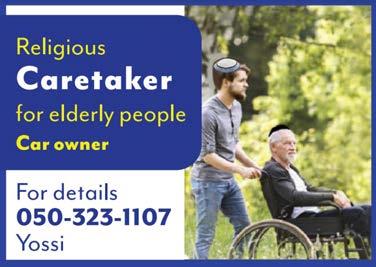
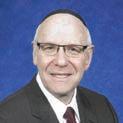
Parashat Emor that we read this week dedicates its first perek (chp. 21) to the laws of kedusha as they apply to the kohanim, specifically. The obligations that the Torah places upon the “priestly class” are meant to help them retain a level of sanctity - one greater than the level demanded of the nation itself. Included in this higher level was the demand that they remain in a total state of tahara when serving in the Mikdash, and, even when not serving the Mishkan/Mikdash, a clearly defined limitation from having contact with the dead. Furthermore, they are also restricted as to what women they may marry and are warned against practicing certain mourning activities.
It is only logical, therefore, that our haftarah reflect a similar theme, which is why Chazal established that the 44th perek of Yechezkel be read on this Shabbat. And, although some of the laws that the navi teaches contain certain stringencies not
found in the Torah itself, we find those differences to be logical ones because, as the Radak explains, the prophet Yechezkel speaks of kohanim whom are the future attendants in the Third Temple and would, therefore, take upon themselves additional rigors. This understandable behavior would reflect an elevated level of sanctity, which would be fitting for the greater sanctity of the never-to-be-destroyed Bet HaMikdash.
As we have pointed out, all of these final chapters of Sefer Yechezkel discuss the “Avoda,”- the sacrificial rites -that would be observed in the future Bet Mikdash. HaRav Moshe Lichtenstein points out that these chapters are unique in that other prophetic messages include prophecies of consolation describing the return of Israel to their land, the rebuilding of destroyed cities, the replanting of lost vineyards and the repopulating of deserted villages. But, although these final perakim of Sefer Yechezkel seem to lack these messages of comfort, they are, indeed, the prophet’s message of consolation. In them, Yechezkel adds to the glorious picture of redemption portrayed by Yishayahu and Yirmiyahu by
28 TORAH TIDBITS 1514 / EMOR
Mazal Tov to Elky
and
Rabbi Winkler's popular Jewish History lectures can be viewed by visiting the OU Israel Video archive: https://www.ouisrael.org/video-library
Grossman
family on the engagement of her son Shlomo to Avigayil Rosenstein
Religious Caregiver Car owner
reminding us that the return of the Temple service would also be part of the geula. After all, it is this navi who often speaks of Hashem’s Shechina, His divine presence, departing from the holy city and it is, therefore, only logical that he now describe the return of G-d’s glory as an essential part-of Israel’s redemption.

I also believe that it is important to note how Yechezkel describes the day to day - almost “mundane” rituals in the Holy Temple and not those of a special day or of a unique service. One might suggest that it is precisely this fact, the idea that sanctity would reign and holiness would abound on a daily basis that the prophet is emphasizing. The navi subtly teaches that the extraordinary impact of the geulah would not be seen only on “special” days and “special” occasions but would become part and parcel of daily life in the Holy Land. This, indeed, is the goal of geulh: to create an independent state of Israel, living together peacefully in the Land of Israel and, thereby, drawing closer to the G-d of Israel.
It is in this way, that we can become a true “mamlechet kohanim v’goy kadoch” –a complete nation that can reach the level of “kohanic” sanctity depicted by Yechezkel.
LIFE SETTLEMENTS


Do you have a life insurance policy you:
• No longer want?
• No longer need?
• Can no longer afford the premium?


• You could use extra money instead of keeping your policy?

I can guarantee that if you qualify with the underwriting process I can get you more money than if you cash it in with the company.
Please contact Moshe Russell at: Buymypolicy32@gmail.com
FOR RENT
3 AUTHENTIC CHARACTER STUDIO APTS, NACHLAOT, JLM
1 room|Ground floor|20m²|renovated|furnished with shared yard of ~15m²|NIS 4,600/month
1 room|Ground floor|18m²|renovated|furnished with shared yard of ~15m² |NIS 3,800/month
1 room|Ground floor|20m²|renovated|furnished NIS 4,500/month

AVAILABLE IMMEDIATELY! Tehila: 050-420-5333
& AIRY APT, MACHANE YEHUDA, JLM 2BR |4th floor |45m² built |4m² balcony NIS 1,910,000 - Mendel: 052-720-3497
FOR SALE AIRY AND BRIGHT APT, MEKOR HAIM, JLM 3BR|3rd floor|100m²|2 balconies|in new condition NIS 3,880,000 - Ouriel: 058-516-1356
FOR SALE SPECTACULAR PENTHOUSE, OLD KATAMON, JLM 4.5 BR penthouse |140m²| roof terrace with view NIS 7,490,000 - Noa: 052-870-2387
FOR SALE
ATTRACTIVE PROPERTY, NACHLAOT, JLM 2 BR | 65m²|balcony|parking|storage NIS 2,730,000 - Tehila: 050-420-5333
Exptected occupancy: Dec. 31st '23
FOR SALE APT WITH GORGEOUS VIEW, HAR HOMA, JLM 3BR|81m²|2 bathrooms |Ground floor out of 5 PRICE REDUCTION! NIS 2,980,000 - Ouriel: 058-516-1356
FOR SALE
FOR SALE
FOR SALE
FOR SALE
FOR SALE
FOR SALE
FOR SALE: AMAZING DUPLEX PENTHOUSE, EFRAT: 4 BR, 168 sqm | large balconies |3 exposures NIS 3,895,000 - Noa: 052-870-2387
COTTAGE WITH TREMENDOUS POTENTIAL, EFRAT 5BR |176m²|3 baths| garden |sukkah balcony PRICE REDUCTION! NIS 3,300,000 - Noa: 052-870-2387
COTTAGE WITH TREMENDOUS POTENTIAL, EFRAT 6BR|190m²|on 4 levels|3 baths|sukkah balcony
NIS 3,690,000 - Noa: 052-870-2387
BEAUTIFUL SEMI-DETACHED HOME, EFRAT 5BR |3 stories |180m² built |160m² garden
NIS 4,950,000 - Noa: 052-870-2387
FABULOUS APT WITH CHARMING YARD, MITZPE YERICHO 6BR | 165m² built | 70m² garden|storage unit
Price reduction! For more info: Mordechai: 052-720-3089
PRIVATE HOME WITH STUNNING VIEW, MITZPE YERICHO 5BR|4 baths|330m² built|500m² lot|sukkah balcony
NIS 4,300,000 - Mordechai: 052-720-3089
OU ISRAEL CENTER 29
BS″D Real Estate | Investments | Management services Noam Homes THIS IS THE TIME TO MARKET YOUR PROPERTIES IN A REAL ESTATE OFFICE WITH EXCELLENT EXPOSURE! Scan to visit our site www.noamhomes.com BS″D Scan to visit our site www.noamhomes.com Real Estate | Investments | Management services www.noamhomes.com | office@noamhomes.com Noam Even 058-793-2222 2020 From your friends at NOAM HOMES Real Estate Professionals The TOP 10 Real Estate Office in Jerusalem for 2020 & 2021 (MADLAN) HAPPY Passover NACHLAOT Great Investment Property, devided into 3 units! Beautiful 5 room duplex, built to a high standard! Lot with with Complex private Authentic 5.5 room Home with character and beauty! MALCHA NACHALAT ACHIM GERMAN Look for us: NOAM HOMES Noam Homes 24 Even Sapir St., Jerusalem 058-793-2222 office@noamhomes.com FOR SALE AMAZING GARDEN APT, BET HAKEREM, JLM 4BR|179m²|on
levels|180m² garden|renovated NIS 8,400,000 - Tehila: 050-420-5333 FOR SALE 2 RENOVATED STUDIO
NIS
SALE
3
APTS, MACHANE YEHUDA, JLM 2 rooms|3rd floor|15+18m²|rented out for NIS 2700+2500
1,590,000 - Tehila: 050-420-5333 FOR
COZY
Unique Aspect of Shavuot

In Parshat Emor we encounter a list of the holidays, including Rosh Hashana, Yom Kippur, Pesach, Shavuot and Succot. With respect to all but one holiday, the Torah states the date of the holiday, followed by the mitzvot associated with that holiday. For example: Pesach:

Lord. (Vayikra 23:33)
And you shall take for yourselves on the first day, the fruit of the hadar tree, date palm fronds, a branch of a braided tree, and willows of the brook, and you shall rejoice before the Lord your God for a seven day period. (Vayikra 23:39).
We are first informed that the holiday of Succot is on the 15th day of the seventh month, and only later instructed to take the daled minim on that day.
Rosh Hashana:
And on the fifteenth day of that month is the Festi val of Matzot to the Lord; you shall eat matzot a seven day period.
We are first instructed that Pesach falls on the 15th of Nissan and then commanded to eat matzot. Succot:
saying: In the seventh month, on the first of the month, it shall be a Sabbat for you, a remembrance of [Israel through] the shofar a holy occasion. (Vayikra 23:24)
We are first informed of the date of Rosh Hashana and then commanded to blow the shofar on that date.
Speak to Bnei Yisrael, saying: On the fifteenth day of this seventh month, is the Festival of Succot, a seven day period to the
However, with respect to the holiday of Shavuot we are instructed of the required actions, waving of the omer, prior to being provided with the date of the holiday. In fact, no date appears! Rather we are told to count seven weeks in order to declare the holiday and offer the appropriate sacrifice (korban Ha’omer).
30 TORAH TIDBITS 1514 / EMOR
RABBI SHALOM ROSNER
Rav Kehilla, Nofei HaShemesh Maggid Shiur, Daf Yomi, OU.org Senior Ra"M, Kerem B'Yavneh
הֶּזַה ׁשֶדֹחַל םֹוי רָׂשָע ה ָּׁשִמֲחַֽבּו תֹוּצַמ םי ִמָי ת ַעְבִׁש 'הַל תֹו ּצַּמַה ג :ּולֵֽכאֹּת
ׁשֶדֹחַל םֹוי רָׂשָע ה ָּׁשִמֲחַּֽב רֹמאֵל לֵאָרְׂשִי י ֵנְּב־לֶא ר ֵּבַּד )גל:גכ ארקיו(:'הַֽל םיִמָי ת ַעְבִׁש תֹו ּכֻּסַה גַח ה ֶּזַה יִעיִבְּׁשַה םיִרָמְּת תֹ ּפַּכ רָדָה ץֵע י ִרְּפ ןֹו ׁשאִרָֽה ם ֹוּיַּב ם ֶכָל ם ֶּתְחַק ְלּו םֶכיקֹֽלֱא 'ה יֵנְפִל ם ֶּת ְחַמְׂשּו לַח ָנ־יֵבְרַע ְו תֹ בָע־ץֵֽע ףַנֲעַֽו )טל:גכ ארקיו( םיִֽמָי ת ַעְבִׁש
מאֵל לֵאָרְׂשִי י ֵנְּב־לֶא ר ֵּבַּד םֶכָל הֶיְהִֽי ׁשֶד ֹחַל ד ָ חֶאְּב יִעיִבְּׁשַה )דכ:גכ( :ׁשֶדֹֽק־אָרְקִמ הָעּורְּת ןֹו רְכִז Speak to Bnei Yisrael,
ם ֶכָל ן ֵתֹנ יִנֲא רֶׁשֲא
)י:גכ ארקיו(:ןֵֽהֹּכַה־לֶא םֶכְריִֽצְק
Please note the updated mailing address for the OU Israel Center: OU Israel
Speak
Yisrael and
them: When you come to the Land which I am giving you, and you reap its harvest, you shall bring to the kohen an omer of the beginning of your reaping. (Vayikra 23:10)
And you shall count for yourselves, from the morrow of the rest day from the day you bring the omer as a wave offering seven weeks; they shall be complete. (Vayikra 23:15)
In fact, in Parshat Pinchas, when the sacrifices of each holiday are enumerated, Shavuot is presented in a similar manner.
22 Keren Hayesod
POBox 1441
Jerusalem 9101302

For Sale
Shifras' Properties!
Unique Renovated - Rechavia/Shaarei Chessed apartment!! Amazing location, 4 rooms, 4 balconies (one sukka), storage, first floor, 5.9 m nis
Amazing deal! Talbia renovated apartment! 3 bedrooms, parking, elevator, balcony, private land, 4.5 m nis
SHIFRA LOPIAN 0526735300
HANASSI WEDNESDAY MORNING LEARNING PROGRAM
Join Us for the Six–Week Series, Two Shiurim Each Week

Wednesday, May 10th to Wednesday, June 14th
First shiur at 10:00 a.m.
Given by Rabbi Yitzchak Breitowitz
Topic: Jerusalem and the Temple Mount; Past, Present and Future
Second shiur at 11:15 a.m. May 10th and 17th, June 7th and 14th

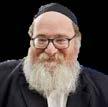
Given by Rabbi Binyamin Zimmerman
Topic: The Eternal Shabbat and 21st Century Technology

Second shiur at 11:15 a.m. on May 24th, May 31st


Given by Rabbi Doron Podlashuk
Topic: To be announced
OU ISRAEL CENTER 31
אישנה תסנכ תיב – היבחר ריעצה לארשי B Be it Knesset Hanassi · Young Israe l of Rehav ia · Ussishkin 24, Jerus alem Adm ission: 30 NIS in person only
a.m. Shavuot ץֶרָאָה־לֶא ּואֹ בָת־יִּֽכ םֶהֵלֲא ָּתְרַמָֽאְו לֵאָרְׂשִי יֵנְּב־לֶא ר ֵּבַּד רֶמֹע־תֶא םֶתאֵבֲהַֽו ּה ָריִצְק־תֶא ם ֶּתְרַצְקּו
Refreshment break 11:00 to 11:15
רֶמֹע־תֶא םֶכֲאי ִבֲה םֹוּיִמ תָּבַּׁשַה ת ַרֳחָּֽמִמ םֶכָל ם ֶּתְרַפְסּו )וט:גכ( :הָניֶֽיְהִּֽת תֹמיִמְּת תֹו תָּבַׁש עַבֶׁש הָפּונְּתַה
תי ִׁשאֵר
Bnei
to
say to
'הַֽל הָׁשָדֲח הָחְנִמ ם ֶכְבי ִרְקַהְּב םי ִרּוּכִּבַה םֹו יְבּו
On the day of the first fruits, when you offer up a new meal offering to the Lord, on your festival of Weeks; it shall be a holy convocation for you, and you shall not perform any mundane work. (Bamidbar 28:26)
In Parshat Pinchas as well, initially we are informed of the mitzva of the day and only subsequently that it is a holiday and work is prohibited.

Why is the presentation reversed with respect to Shavuot? In addition, why is the term תבשה תרחממ used? It has created a controversy among the nation – it would have been much clearer to refer to Pesach rather than Shabbat, so what is the term Shabbat used? Moreover, we are instructed to waive the Korban – that is not required with all sacrifices. Why is tnufa required in connection with the sacrifice on Shavuot?
Infusing the Mundane with Holiness
Rav Eliyahu Blumensweig (V’Hithalachi Bitochechem) offers a significant insight. Shabbat is declared by God. He created the world in six days and rested on the seventh. The actual date of the other holidays is determined by God as well (although we determine the calendar). However, the holiday of Shavuot is determined by man and his actions. Perhaps that is why the mitzvot of the day precedes its date. Only once the mitzvot are fulfilled can one arrive at the true essence of the holiday. If one does not perform mitzvot and lacks appreciation of the Torah, the holiday of Shavuot, when the Torah was given to Bnei Yisrael lacks significance. We need to act to sanctify the holiday. Matan Torah- the giving of the Torah, is only possible with a willing a
worthy recipient!
Shabbat and Pesach – Divine; Shavuot- Mundane
The term used is תבשה תרחממ – to highlight the contrast between the holiday of Pesach – like Shabbat, where God’s supernatural powers were evident and the holiday of Shavuot, where we need to infuse holiness into the mundane. Korban Ha’omer is brought from barley, symbolizing basic food typically eaten by animals (similar sacrifice offered by a Sota), leading up to fruit brought to the Mikdash on Shavuot, which is celebrated by man. On Pesach we refrain from chametz and eat simple matzah. On Shavuot, as part of our offering we include Hametz, possibly to underscore man’s required addition to the basic recipe, again symbolizing man’s necessity to act in order to grow and properly receive the Torah.
Tnufa- Shake Us Up
Whereas on Pesach we witnessed down below miracles from above, the days of the omer require us to raise our earthly matters with sanctification. To transform from passive by-standers to active participants in observing God’s commandments. That is why the Korban Omer undergoes a waving –tnufa– we need to uplift ourselves and our actions to be worthy of receiving the Torah. May we utilize these seven weeks to properly prepare for Shavuot and truly appreciate the essence of the day.
32 TORAH TIDBITS 1514 / EMOR אֹל הָדֹבֲע תֶכא ֶלְמ־לָּכ ם ֶכָל ה ֶיְהִֽי ׁשֶד ֹק־אָרְקִמ םֶכיֵתֹ עֻבָֽׁשְּב )וכ:חכ רבדמב( ּוֽׂשֲעַֽת


OU ISRAEL CENTER 33 My Dear Student, We have been making our way through our five core values and have finally arrived at the last and, from an individual and national perspective, In The Final Exam, Rabbi Dr. Ari Berman, presents the core Torah values that inspire a life of wisdom, contribution and purpose through the powerful medium of personal letters. He encourages his readers to integrate these values into a life of faith and religious integrity that sets as its goal a path to redemption. New Book from
Berman
and Rosh Yeshiva, Yeshiva University and Rabbi Isaac Elchanan Theological Seminary (RIETS) Purchase now at yu.edu/thefinalexam
Rabbi Dr. Ari
President
SMILES Faculty, OU Israel Center
Lessons of the Land
There is a curious juxtaposition in our parashah this week that demands further understanding. The Torah lists the various holidays along with their korbanot and the details of each chag (Vayikra 23;2-44). After speaking about Shavuot, before Rosh Hashanah, the Torah inserts a set of laws that not only has been mentioned earlier but seem to have no relevance to the chagim (Vayikra 23;22). What significance could the laws of peah and leket, leaving a corner of the field for the poor, have at this particular point?
The Meshech Chochmah relates that these laws are positioned here specifically to underscore an important lesson about Torah living. One may think that the holiday of Shavuot is all about bein adam laMakom, laws between Hashem and mankind. The placement of peah and leket here emphasizes that interpersonal laws are also a fundamental part of Torah. How we treat others emanates from Divine directives. The fabric of our interpersonal relationships can’t be the whim of mankind or based on personal agendas, rather, it is
Torah that guides us how to relate to each other and how to treat each other.
Rav Chaim Volozhin’s son notes that his father would consistently tell him that people are created to help others. Even if one can’t always actively assist another, one can feel their pain, and daven for them. Rav Schorr explains that perhaps this is why one’s heart is situated on the left side of the body, albeit the right side is usually the stronger side. When one is standing opposite his friend, his heart faces the right side of the other person, indicating that the other person’s heart should be the priority. Our heart, our feelings, and ultimately our actions, are meant to benefit others. Putting this mitzvah now highlights the importance of thinking of others with consideration and concern.
Rav Scheinerman in Ohel Moshe sees this mitzvah as an introduction of sorts to the holiday of Rosh Hashanah. Taking care of those less fortunate is akin to kabalat Ol Machut Shamayim, accepting upon oneself the Yoke of Heaven, the over-arching theme of Rosh Hashanah. Since the Torah links gifts of the poor with Rosh Hashanah in this section, it is perhaps the source for increasing tzedakah during the days between Rosh Hashanah and Yom Kippur. We show Hashem, “I care about Your children, I care about You.”
34 TORAH TIDBITS 1514 / EMOR REBBETZIN SHIRA
המלש האופר אנדהאב לרפ ןב עשוהי םהרבא
Be’er Moshe delineates how the laws of peah and leket express the acceptance of the Yoke of Heaven. One who can leave aside a part of his field for the poor is a person who recognizes that ultimately the field belongs to Hashem, we are simply His emissaries to watch over His property. This mitzvah reminds us that ultimately, we control nothing in our lives, everything is a gift from Above, to use properly and meaningfully. It symbolizes Hashem’s complete control and mastery over this world and our mandate to expand beyond ourselves.











Rav Birnbaum in B’karei Shemo adds that one who has this recognition can accept the Yoke of Hashem’s kingship. Such a person understands the depth of Torah, the message of Shavuot, and what it means to be an eved Hashem, the theme of Rosh Hashanah.

OU ISRAEL CENTER 35
NAHARIYA, IL 3 BEDROOM 4 BEDROOM w/ SEA VIEWS 1.47M NIS 1.75M NIS $401k USD * $447k USD * BAT YAM, IL 2 BEDROOM 4 BEDROOM 3.07M NIS 3.5M NIS $837k USD * $954k USD * NETANYA, IL 4 BEDROOM 4 BEDROOM NO CONSTRUCTION w/ Sea View INDEX 3.15M NIS 3.65M NIS $866k USD * $1.0M USD * ASHKELON, IL 3 BEDROOMS w/ SEA VIEW 2.25M NIS - 2.95M NIS depending on Flr # NEW
Call For Details Izzy Leizerowitz +972 52 682-9367 USA 786 385-8859 *USA BUYERS - THE DOLLAR IS AT 3.6 NIS; WHAT ARE YOU WAITING FOR? ATTENTION !
APARTMENTS NEAR THE SEA
Mashpiah, OU-NCSY Executive Director, Camp HASC Author of Baderech: Along the Path of Teshuva (Mosaica 2021)
Pesach Sheini: Again, From Close
Rav Yisroel Yitzchak haLevi Reisman, zt’l, was a Lelover chasid, born in the Old City of Yerushalayim. A trusted gabai tzedakah, he served Hashem with extraordinary humility, and was invited by Rav Yosef Chaim Zonnenfeld to serve as a dayan, a judge for the Eidah Chareidis. Known for sweeping expertise in Shas and poskim, he was one of founders of Yeshivah Sefas Emes and ultimately became the Ra’avad (Rosh Avos Beis Din) of Yerushalayim.

Rav Yisroel Yitzchok once arrived in Bnei Brak for a meeting with the elderly gadol ha-dor, the Chazon Ish. As he was ushered into the office, he saw that the Chazon Ish was preoccupied, mentally absorbed, and perhaps unaware of his presence. “Shalom Aleichem,” he intoned gently, after waiting a minute or two, “may I ask what the Rav is doing?” The Chazon Ish looked up and answered, “Aleichem Shalom. What am I doing? I am doing what Yidden do… I’m doing teshuvah!” The visiting dayan looked at the sage inquisitively. “I do a cheit, a sin,
and then I do teshuvah,” continued the Chazon Ish, “again I sin… and again I do teshuvah.”
One year after Yetziyas Mitzrayim on Rosh Chodesh Nisan, in the Desert, Am Yisrael was commanded in bringing the Korban Pesach. The People followed through and observed the Yom Tov as Hashem had requested — except for one ‘unforeseen’ issue:
Anyone who is ritually impure or on a distant road (and as a result is unable to bring the Korban Pesach in the commanded time).... (Bamidbar, 9:10)
A group of Jews were at that time tamei l’nefesh, ritually impure, having come into contact with death. When Chag haPesach came, meaning the 14th of Nisan when the Korbanos were to be offered, they were unable to bring a Korban, as one can only bring the offering in a state of taharah. Not wanting to lose out on the mitzvah, however, vayikr’vu el Mosheh, “they drew close to Moshe”, and presented their sh’eilas rav: ערגנ המל, “Why should we be prevented from bringing a Korban and drawing close?”
Moshe responded, ‘Imdu, stay where you’re standing; please hold, I’ll ask Hashem and get back to you.’ Moshe stepped away, rang the Ribbono shel Olam, and received an immediate response: “Anyone who
36 TORAH TIDBITS 1514 / EMOR
JUDAH
RABBI
MISCHEL
…הָקֹחְר ְךֶרֶדְב ֹוא ׁשֶפֶנָל אֵמָט־הֶיְהִי־יִּכ ׁשיִא ׁשיִא
המלש האופר האל היח ןב םייח עשוהי
is tamei l’nefesh — and not only that, but anyone who is on a derech rechokah, a distant road, and not just now but for always — they shall bring a Korban Pesach on the Second Month (Iyar), on the 14th day….”
They would have a second chance. They would have Pesach just like everyone else, only a month later.
Rebbe Yisroel of Ruzhin expounds upon the Mishnah ( Pesachim, 93b): “What is the definition of a derech rechokah, a distant road? Rabbi Eliezer says it is ץוחלו הרזעה תפוקסאמ, from the threshold of the Azara (Temple) courtyard and beyond.” This teaches us that a person can be zocheh to arrive in Yerushalayim, ascend Har haBayis, and even make it all the way to the entrance of the Azarah, the Courtyard of the Beis haMikdash — and yet he still is on a ‘distant road’; he still has a long way to go, because he is still sees himself as impure, in a state of cheit , having missed the mark.” In his nefesh, his consciousness, he is not yet tahor, pure, and so despite his physical proximity to where he is to bring the Korban Pesach, this Jew experiences an inner distance.
We may be proficient in performing mitzvos according to all the halachos and minhagim. We may be ‘close’ to where we need to be, both physically and intellectually. Yet, at times we can feel spiritually far away, baderech rechokah, as if we are on a distant road. It may seem as if we are unable and unworthy of entering the ‘Courtyard’ of Hashem’s Presence to ‘bring our offering’.
Reb Chatzkeleh of Kuzmir suggests an understanding of the roots of the Pesach
Sheni narrative: “Imagine. A Jew is standing at the threshold of the Azara, yet does not enter! Only because of our excessive, false humility and low self-esteem, we doubt ourselves, as if to say, ‘Who am I to approach this holy place?’ Prevented by haunting feelings of guilt and shame, again and again we attempt to enter, but are not able. The distance is imagined; a construct of our yetzer hara and hardened hearts…. Therefore HaKadosh Baruch Hu says, ‘If so, just for that I will make a (new) Yom Tov for you, to show you how I desire your closeness!’”
A Jew once asked Rebbe Yisrael of Ruzhin, “Rebbe, I so deeply desire to do teshuvah, but I don’t know what to do about it.”
“And when doing an aveirah, you knew then what to do?”
The Jew blushed and confessed, “Yes, but that was simple: I had a taavah, a desire, and I just acted upon it.”
“Aha,” said the Ruzhiner. “Exactly! Now do the same... You have a taavah for teshuvah; just act upon it!”
Pesach Sheini, is the ‘headquarters’ of our belief that desire for holiness, our taavah for another chance, matters. It is a Divine invitation to collapse the imagined distance and just walk right into the ‘Courtyards’ of His presence.
No matter how far we may feel on our individual or collective derech rechokah, no matter our sense of tumah or lack, this Pesach Sheini may we “do what Yidden do”. May we have the confidence and faith to take one more step toward actualizing our ratzon, and enter the realm of holiness.
OU ISRAEL CENTER 37

38 TORAH TIDBITS 1514 / EMOR

OU ISRAEL CENTER 39

40 TORAH TIDBITS 1514 / EMOR

OU ISRAEL CENTER 41


42 TORAH TIDBITS 1514 / EMOR


OU ISRAEL CENTER 43
SHIUR SPONSORS
Thursday, April 27 - Rabbi Bienenfeld’s Gemara shiur is sponsored in loving memory of Reuven ben Shmuel haLevi Wolfeld z”l by his wife Rose - Yahrzeit was 6 Iyar
Monday, May 8th - Rebbetzin Pearl Borow’s shiur is sponsored by Noni & Eddie Weiss & Family in loving memory of Noni’s mother
Phyllis Sunshine a”h - Chaya Faygl bat Yosef Wolf a”h on her first yahrzeit רייא וט
Monday, May 8th - Rebbetzin Pearl Borow’s shiur is sponsored by Stephen & Nadine Cohen in memory of their dear mother/mother-in-law Sonia Hoffman a”h yahrzeit - רייא זי - May 8
Rabbi Goldscheider’s shiur has been sponsored for the 2023 Academic Year
ל’’ז המלש ןב בוט םשו ה’’ע םהרבא תב םירמ תמשנ וליעל
Rebbetzin Shira Smiles shiur is sponsored for the 2023 academic year by Dr. & Mrs. Menachem Marcus in memory of their parents, Rose & Dr. Emanuel Marcus z”l -
ל”ז סוקרמ השמ ןב יכדרמו ריאמ ףסוי תב לזייר Rosi and Ernest Strauss z”l -
ל”ז סוארטש דוד ןב לאינדו םהרבא תב דומיל
Rabbi Breitowitz’s Tuesday Shiur - Minchat Chinuch is sponsored for the academic year 2023 by Rabbi Refoel & Sharon Auman in memory of their parents Edith & Reiner Auman z”l
ד”יה לאפר תב ה”ע רתסאו ל”ז קודצ ןב הנוי and their son Rabbi Shmuel Eliyahu Auman z”l
י”נ לאפר ברה ןב ל”ז והילא לאומש ברה
Rabbi Goldin’s shiur is sponsored for the 2023 academic year by Dr. & Mrs. Menachem Marcus in memory of beloved aunts
Irma Haas a”h and Hilde Myer a”h
Rabbi Manning’s shiur has been sponsored for the 2023 academic year
ל’’ז ןמלק ןב גילזו ה’’ע תידנרב תב הנרב תמשנ יוליעל
Rabbi Taub’s weekly Thursday Parshat HaShavua Shiur is sponsored by The Jewish Legacy Foundation
DOROT - The OU Women's Intergenerational Choir
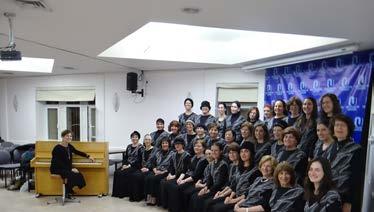
Director Hadassah Jacob 052-384-7230
Monday Evenings 7:00 - 9:00pm
PRI HADASH
WOMEN'S WRITING WORKSHOP AT THE OU ISRAEL CENTER
Monday mornings 10.30-12.30
For more details, call Ruth 02-628-7359 or Judy 054-569-0410
GET FIT WHILE YOU SIT: Exercise for ladies
Join us on Sundays 12:45-1:30pm at the OU Israel Center Sura Faecher 0504153239
Please note: Deadline for ads for the Shavuot/ Shabbat Parshat Naso issueThursday, May 18th

please email or call Ita Rochel ttads@ouisrael.org/ 02-5609125
SHABBAT AFTERNOON SHIUR WITH RABBI CHANOCH YERES outside the back of the OU Israel Center at 5:00pm
A small Sefer Torah with its own Aron Kodesh is available to shiva houses or for any other necessary occasion on a temporary free-loan basis.
If needed call Uri Hirsch 0545513173
44 TORAH TIDBITS 1514 / EMOR


OU ISRAEL CENTER 45

46 TORAH TIDBITS 1514 / EMOR

OU ISRAEL CENTER 47
In just a few days we will commemorate Lag B'Omer, when we reflect on the tragedy that befell the 12,000 pairs of students of Rebbe Akiva. Indeed most of us associate Lag B'Omer primarily as the end of the customary mourning period for Rebbe Akiva's many students who were lost.
However, our Chazal teach us that following the tragedy that befell those many new students, Rebbe Akiva started from the beginning and developed a new generation of disciples including Rebbe Shimon Bar Yochai, who restored the glory of Torah throughout Eretz Yisrael. Of course Lag B'Omer is observed as the hillula, the celebration of the life and legacy of Rebbe Shimon Bar Yochai; the Arizal, referred to Lag B'Omer as yom simchato shel RashbiThe Celebratory day of Rashbi.
The very obvious question to be asked is what is so significant about Rebbe Shimon Bar Yochai, what makes Rebbe Shimon so unique, that we celebrate his life and legacy perhaps more significantly than any of our other tzadikim?
Rav Moshe Wolfson, shlita points out that Rebbe Shimon Bar Yochai learned from his teacher Rebbe Akiva, that every single letter in the Torah contains many thousands of secrets, each letter is valuable and important well beyond its face value. Rebbe Shimon Bar Yochai explained further that every single Jewish soul corresponds to an Ot, a letter in the Torah. If
BY RABBI SAM SHOR Program Director, OU Israel Center


each individual letter contains immeasurable secrets and meaning, then so too we must infer that every single neshama has immeasurable value and significance!
Rav Wolfson suggests that Lag B'Omer is indeed the tikkun for the tragic episode of the 12,000 pairs of Rebbe Akiva's students, who failed to see the value in one another's scholarship, and failed to treat each other with dignity and respect. We celebrate the life of Rashbi, as his legacy serves in contrast to Rebbe Akiva's earlier disciples, and reminds us of the inner importance and sanctity of each and every member of Klal Yisrael.
Yehi Ratzon, may we merit to emulate the path of Rebbe Shimon. May we learn to see the good in one another and to appreciate that each and every neshama is both unique and sacred..
Lag Sameach!
48 TORAH TIDBITS 1514 / EMOR
SIMCHAT SHMUEL




OU ISRAEL CENTER 49
BY RABBI MOSHE TARAGIN R am, Yeshivat Har Etzion
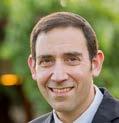
Blood Libels and the Perversion of Jewish Values
Rabbi Jonathan Sacks likened antisemitism to a virus. Unlike bacteria which can survive independently, a virus is completely dependent upon its host. As with all parasites, a virus invades the host, takes control of its functions and suctions off its resources. Like a virus, antisemitism cannot exist on its own, but must be fueled by a cultural narrative. Without a storyline to justify hatred and discrimination, antisemitism cannot be sustained.
Antisemitism is like a virus in a different manner: it constantly mutates. As culture evolves, the antisemitic narrative also changes. Ancient antisemitism was theological, the product of a religious battle between paganism and monotheism. By introducing the notion of one G-d responsible for all reality, we challenged the pagan imagination and contested its freewheeling and hedonistic lifestyle. Paganism portrays a cavalcade of warring gods, none of whom hold human beings morally accountable. Without divine moral surveillance Man is free to pursue his own menial lusts or
violent behavior. By asserting one G-d with moral expectations, we called humanity to higher moral ground, demanding a lifestyle of moral integrity and austerity.
A midrash describes the intrusion of pagan vandals into the first mikdash, as it was being dismembered by the Babylonians. They made a beeline for the gold keruvim which were shaped as cherubs. Publicly parading these gold figures, these trespassers mocked us as hypocrites: “evidently, despite Jewish opposition to idol worship, Jews, themselves were addicted to molten images.” Of course, we never worshipped the keruvim, but this sorry spectacle highlights how abrasive our message of monotheism was to the ancient pagan imagination.
Enduring tensions with both Greece and Rome were also pivoted upon our severe demands for a life of mitzvot and of moral temperance.
The First Mutation
Gradually, as the world veered toward monotheism, a new antisemitic narrative was required. During the 4th century the Roman empire converted to Christianity, and during the 7th century Islam began its meteoric rise. Within a few centuries the ancient pagan world of physical images and human-like gods was washed away by the currents of monotheism. We could no longer be hated for our bold theological revolution, since our ideas had pervaded
50 TORAH TIDBITS 1514 / EMOR GEULAS YISRAEL
humanity and captured its religious consciousness. Antisemitism, in order to survive, required an updated narrative.
Tragically, Christianity crafted a bogus and noxious story which would lead to thousands of years of violence and torture of Jews. Starting as early as the late 1st century, we were falsely accused of killing Jesus, despite incontrovertible evidence to the contrary. Tragically, this baleful lie, which was only formally repudiated by the church in 1965, would become the base narrative for institutionalized Christian antisemitism throughout the Middle Ages. In particular, beginning with the First Crusade of 1096, this false accusation was employed to rile mobs of angry thugs to murder defenseless Jews, believing that they were rectifying age-old religious crimes perpetrated by the Jews.

Blood Libels
Sadly, this false narrative generated a sub-narrative. Not only did we kill Jesus, but we continued to reenact this heinous crime. In the 12th century the first recorded blood libel was launched in England, as we were accused of killing a Christian child to employ its blood for Pesach matzot. This false accusation, unsubstantiated by any facts, quickly spread throughout Europe, ultimately infecting the Islamic world, where it is still parroted as part of anti-Israeli propaganda. Over the past millennia hundreds of blood libels have been responsible for the countless murder of innocent Jews. It is hard to imagine a lie in the history of mankind which has been more toxic and murderous. It is a shameful invention which lives in infamy and, sadly, continues to infect those looking for reasons to hate.
OU ISRAEL CENTER 51
Distorted Narrative
Tragically the story isn’t just baseless, but is also a complete distortion of Judaism. This horrific accusation clashes with our core values and our centuries-old religious culture. This sub-narrative is not just murderous, but insulting to Jewish belief.
The Dignity of Man
In His compassion, Hashem fashioned Man with unique, godlike qualities such as intelligence, cognitive speech, and creativity. These gifts separate us from the animal kingdom and demand that we protect human dignity. By preserving human dignity and by constructing civil societies to protect individual freedom and worthiness, we protect Hashem’s divine installment. The Torah’s emphasis upon chesed reflects its concern with human dignity. The depletion of human potential through suffering and misfortune is a divine tragedy which can only be rectified through acts of chesed, which restore and redeem this lost divine potential.
Furthermore, not only is the human spirit divine-like, but even the human body was carefully crafted with divine attention. Judaism avoids any bifurcation between body and soul, asserting, instead, their unity. Hashem created us as one unified blend of body and soul, each possessing divine qualities and each possessing divine dignity.
Halacha and the Dignity of the Body
For this reason, Jewish respect for the human body was always paramount. Parshat Emor delineates prohibitions of disfiguring the human body during grieving. Though the Torah directly targets Kohanim, the gemara quickly extends this issur to
is reluctant to send Yishmael away and Yitzchak seeks reconciliation with Yishmael and seeks to bless Esav.
every Jew. םכיקולא הל םתא םינב - because we represent Hashem, we take extra precautions not to mutilate the human form. We are expected to live with greater nobility, greater hygiene, and greater dignity. We are ambassadors of Hashem, and, in us, the world must see Hashem and the dignity of םיקולא םלצ.
6th Aliya (25:1-11) Avraham marries Keturah; they have 6 sons. All that Avraham has goes to Yitzchak; these are sent eastward with gifts. Avraham dies at age 175; he is buried by Yitzchak and Yishmael in Ma’arat Hamachpelah. Yitzchak is blessed by G-d: he lives in Beer L’chai Roi. The transition from Avraham to Yitzchak is complete. While G-d has been a silent partner in this parsha, here He completes the generational transfer – He blesses Yitzchak. The Jewish people will be Yitzchak and not Yishmael.
For these reasons, we were strictly forbidden from consuming any blood- human or animal. Since Acharei Mot is so adamant about forbidding consumption of blood, kosher meat requires meticulous salting to drain even minute particles of animal blood. Likewise, the mitzvah of kisui hadam instructs that many meats can’t be processed or eaten until their blood has been covered.
7th Aliya (25:12-18) The generations of Yishmael are enumerated. Yishmael dies. His descendants dwell from Egypt to Assyria. Yishmael’s story is brief. He has numerous and powerful offspring. The brevity
Hashem doesn’t want us to become entangled in a world of blood. Humanity has always sensed a mystic draw to the life force of blood, and blood lust has always fascinated the darker parts of the human imagination. Ancient voodoo customs and pagan black magic were pivoted upon blood rituals and blood consumption. Blood fascination plunges us into a dark underworld of death and black magic. Distancing us from this degrading and disgraceful world, the Torah repeatedly cautions against any intake of blood. We are a nation of dignity and, as servants of Hashem, we respect the human body, avoiding disfiguration and blood obsession.
is interested the Jewish length. echoes tions woman and began father’s that his icant the
A SHORT VORT
BY RABBI Rav, Beit Knesset
When Avraham addresses the people of Cheit, trying to “Ger V’Toshav Anochi Eimachem” (23:4) “A Stranger and This seems to be a contradiction. If one is a stranger than is no longer a stranger. What did Avraham mean?
The Magid of Dubno (Jacob ben Wolf Kranz 1741-1804) this tense situation in order to, both, state his truth and be said, on the one hand, “I am a Resident’ due to G-d’s promise need your agreement to purchase a plot. In other words, Avraham “strangers”, while they understood him as saying that “they” The peace was kept, and Avraham remained true to his Shabbat Shalom
Additionally, though any pagan worship

52 TORAH TIDBITS 1514 / EMOR
12 TORAH TIDBITS 1440 / CHAYEI SARA 5782
is unequivocally forbidden, human sacrifice, practiced by the Molech culture, is particularly grotesque and nefarious. The Torah announces that Hashem pays specific attention to punish those who engage in human sacrifice. The entire purpose of the akeidah was to debunk any divine interest in human sacrifice.
We do not sacrifice humans to Hashem, and we certainly don’t drink any blood – human or animal. These concepts are anathema to Jewish belief.
Perverting our Narrative
Imagine the horror of medieval European Jews reading the spring-time parshiyot of Acharei Mot, Kedoshim and Emor, which prohibit human sacrifice, bodily defacement and the consumption of blood -all of which threaten the dignity of the human body. Imagine their horror as they faced ridiculous and insulting claims that led to their brutal torture and ruthless murder. If the consequences of these accusations weren’t so hideous, they would be laughable. But such is the nature of antisemitism. Not only does hatred of a Jew generate false claims but, ironically, it perverts basic tenets of our religion and culture. Our values were perverted because history was perverted.
One

We buy old sifrei kodesh, judaica gold, silver, coins, collectables, banknotes, antiques and more…
We were to blame for the perversion of history.
The Perversion of History
Sadly, this perversion of our narrative was forecast in the tochachah, which describes Jewish gallus and the perversion of history. Parshat Ki Tavo describes us being transformed into poisonous “storylines” and into derisive cliches םתייהו הנינשלו לשמל המשל. We became fables of describing uncommitted crimes and stereotypes of hatred. Angry mobs were brainwashed that Jews had murdered little children and having been fomented, it was now easy for them to view Jews as sub-human criminals deserving death and suffering.
The warping of Jewish belief and the weaponization of these perversions, was one of the harshest features of gallus. Not only were we dislocated from our Homeland and discriminated against, but our own narrative was lifted, twisted, and wielded against us in the name of murder.
Part of our redemption is the dismantling of these propagandist lies and the restoration of an accurate Jewish narrative which inspires the world to higher moral ground. The restoration has begun but, sadly, it is incomplete.
Ran: 054-5561223
OU ISRAEL CENTER 53
person’s trash is another person’s treasure…
ל רודמ רוד
Flying Soon? Travel with Confidence
- Medical Insurance at great prices Choose from multiple options 1unitravel.brokersnexus.com
- Sims for USA and Worldwide Starting at $40 sales@1unisim.com Call 077-400-3199 or USA 718-715-0001
1UniTravel
1UniSim
Relocating Synagogues to the Land of Israel

The sanctity that is natural is the sanctity of the Land of Israel, and the Shechinah (Divine Presence) that was exiled with Israel is the ability to preserve sanctity in the face of opposition. But the sanctity that combats nature is not complete sanctity; it must be absorbed in the supernal essence of the higher sanctity, which is the sanctity of nature itself, the foundation of the world’s perfection and complete invigoration. The holiness of exile will be joined to the holiness of the Land. “Eventually the synagogues and study-houses of Babylonia will be relocated to the Land of Israel” (Megillah 29a).
(Eretz
Chefetz 4:4)
The notion that synagogues located outside the Land will be transplanted to the Land of Israel reflects the view that the Jewish life outside the Land of Israel is merely temporary.
The twelfth tenant of the Rambam’s Ikarei Emunah (Tenets of Faith) states the obligation to “await the Redemption” and to anticiapte the Mashiach’s arrival each and every day: “We are to believe and assert that Mashiach will come and not think that he is tardy. ‘Although he may delay, wait for
him’.” (Chavakuk 2:3). In Hilchot Melachim (11:1) as well, the Rambam asserts: “Anyone who does not believe in him or is not waiting for his arrival, denies not only the words of the prophets but also the Torah of Moshe Rabbeinu.”
The eminent Rabbi Moshe Shapira (19172006) poses the question: “Why is it necessary to await his coming? Is it not sufficient to ‘believe’ in this tenant like any of the other tenets of faith?”
“The answer to this question lies in the fact that the main thrust of this tenant is to establish in our minds the true situation of both the Jewish nation and individual members of this nation. We must live with the feeling that the exile is a distortion of the Jewish nation’s existence, an abnormal situation that contradicts our natural being. Mashiach is coming to bring us back to our natural state.” (‘Revel in Emunah’, Feldman, pp. 412-413)
Apparently the belief in the coming of the Mashiach requires that a Jew sustain a continual frame of mind that the state of galut represents an abnormality to the life of the nation.
It is interesting to note that Rav Kook in the passage quoted above from Eretz Chefetz calls for “the holiness of exile to be joined with the holiness of the Land.” Perhaps the sacred characteristics found outside the Land refer to the successes and accomplishments the Jew has achieved in the areas of Torah study, prayer and chessed which must be held dear
54 TORAH TIDBITS 1514 / EMOR
RABBI AARON GOLDSCHEIDER
Editor, Torah Tidbits
and incorporated into our nation’s persona.
The following teaching from the Netziv, one of Rav Kook’s most influential teachers, helps elucidate this idea.
In his commentary to the Torah, Ha’amek Davar (Shemot 34:1), the Netziv suggests a novel approach to explain why the Talmud Bavli is preferred even though the Talmud Yerushalmi is holier. He compares the two Talmuds to the first and second Luchot. Although the first Luchot were holier since they were the handiwork of God, nonetheless the second Luchot are the ones which remained.
In a similar vein, although the Talmud Yerushalmi is holier since it was written by earlier scholars and it has the merit of being written in Eretz Yisrael, nevertheless the Talmud Bavli’s virtue is that it was able to guide us through the darkness of the Galut where we had to invest great effort and sacrifice, in a place where the light of Eretz Yisrael did not penetrate. The Talmudic saying in Sanhedrin (24a) “‘He made me dwell in dark places…’ This, said Rabbi Yirmiyah, refers to the Talmud Bavli.” The Netziv says this is not a derogatory statement about the Talmud Bavli. To the contrary, it comes to teach us that the Bavli was able to enlighten us even in the dark Galut.


When Rav Kook speaks of “the holiness of the exile” he is accentuating the immense commitment, sacrifice, and sheer determination exemplified by so many generations of Jews who endured the exile. Their sacred contribution in Torah study and to prayer will ultimately be wed to the pristine naturalness and the clarity of Torah study and prayer which is found only in the holy environs of Eretz Yisrael.
continued on next page...
NACHI REALTY 054-461-3943
New building under construction in Katamonim on the border of Katamon.
2-5 room apartments. Starting at 2.1m shekel
Last 2 room apartment + mirpeset & underground parking in new building under construction in a great location. 2.15m shekel.
3 & 4 rooms also available

For Rent in the German Colony on Emek Refaim street, 2 rooms, one floor up, good shape, parking. 4,600nis/month

OU ISRAEL CENTER 55
TilleyHatsNowAvailable
The Galut is Temporary
The following anecdote is a reminder to those living outside the Land of its impermanence:
In 1862 Rabbi Zvi Hirsch Kalisher published his book Derishat Tzion that argued for the active settlement of the Land of Israel and not to wait for the Mashiach. Many educated Jews began to debate this position. In the city of Slonim a group of respected leaders came to the door of their rabbi, the gaon, Rav Yehoshua Izek Shapira (1801-1873) known as R. Izel Charif of Slonim, a brilliant and renowned rabbi. They asked him if it is correct, in his view, that one is obligated to act on behalf of rebuilding the Land of Israel or should we simply wait for the coming of the Mashiach.

The was the rabbi’s answer: “In the Amidah that we recite daily there are three blessings that appear one following the other - the
prayer for healing (Refaienu), the prayer for sustenance (Barech aleinu) and the prayer for redemption (Te’ka be’shofar). Therefore, I find your question perplexing for the following reason: When someone is sick at home, do you come to me and ask if it is proper to bring them to a doctor or should we wait for salvation from heaven? When you struggle to make a living, you don't knock on my door and ask me if I should pursue work or wait for a gift from above. And now, regarding the issue of Geulah (redemption), why is it that you are asking me this question. The answer is obvious. Apparently we respond with greater urgency to being sick or when struggling with parsnasa because they affect us personally. Should not the potential for Geulah also elicit our actions; shouldn’t we also pursue it with all our vigor? (Haggadah
Ayalet Hashachar, p.183)
56 TORAH TIDBITS 1514 / EMOR









OU ISRAEL CENTER 57 לארשי ץראל עסמה לארשי ץראל עסמה Swim4Sadna 2023 For further information: info@swim4sadna.org 'Swim4Sadna םישנל תרנכה תחילצ' 0549938840 women ' s kinneret swimathon 10% discount for torah tidbits readers, coupon code TIDBT 1-2.6.2023 ג"פשת ןויס ג"י-ב"י registration is open!
BY REBBETZIN DR. ADINA SHMIDMAN INSIGHTS


HAFTORAH YECHEZKEL 44:15-31
All the choice first fruits of every kind, and all the gifts of every kind—of all your contributions—shall go to the priests. You shall further give the first of the yield of your baking to the priest, that a blessing may rest upon your home. (Yechezkel 44:30)
The Navi Yechezkel outlines the parameters and protocols of the Kohanim and the people’s obligation to support them. Through gifting the Kohanim the first of our fruits, a percentage of our crops and a portion of our dough, we bring blessing into our homes. There is much to be gleaned from these obligations and the deeper meanings they convey.
Bringing produce into one’s home is the culmination of months of effort and highlights man’s personal successes. Yet, man must recognize that it is not the strength of his hand that has yielded this bounty, but rather it is due to Hashem’s generous hand.

Looking at the three gifts to the Kohen provides us with insight on our spiritual mission in a physical world. The first fruit represents the unique life-cycle experiences; the firsts in our lives, Smachot, special
moments. We are tasked to find the spiritual gifts to express gratitude to Hashem for bringing us to these events. The concept of Trumah is that we take crops and by giving them to the Kohamin, we elevate their worth. Today, we can take an object that has no unique spiritual properties and imbue it with sanctity based on our actions. Our thoughts and actions can transform objects that may at first glance not have a spiritual nature, for example we can use our car to run errands and do chesed for others. And finally, the dough tasks us to find meaning in our everyday lives by taking our normal and regular routine and elevating it. In fact, the word challah comes from the word chol - mundane. Everyday eating can become an opportunity for building peace in our homes, sharing Torah thoughts and thanking Hashem for our food.
Through the three gifts to the Kohanim, Hashem is sharing with us how we can create a connection to holiness and bring blessing into our homes. Let us take our home, our Bayit, and through these gifts, create a sanctuary, a Mikdash Ma’at.
58 TORAH TIDBITS 1514 / EMOR
HAFTORAH
םֶכיֵתֹו מּורְּת לֹּכִמ לֹּכ תַמּורְּת־לָכְו לֹכ יֵרּוּכִּב־לָּכ תיִׁשאֵרְו הָכָרְּב ַחי ִנָהְל ן ֵהֹּכַל ּו נְּתִּת םֶכיֵתֹוֽסִרֲע תיִׁשאֵרְו ה ֶיְהִֽי םיִנֲהֹּכַל ׃ָךֶֽתיֵּב־לֶא
Rebbetzin Dr. Adina Shmidman is the founding director of the Orthodox Union Women’s Initiative and the rebbetzin of the Lower Merion Synagogue in Bala Cynwyd, PA.
In the heart of calm and pastoral BAKAPrivate arab house, 6 rooms, 500m + possibility of building 250m, huge garden, approx. 700m, completely renovated, underfloor heating + a/c, large parking, 5 bathrooms, 5 toilets, green
MENDEL 0528980111
BAKA - New penthouse, 4 rooms in a small luxurious building with character, alone upstairs, 3rd floor + elevator, 4 orientations, 3 toilets, 2 bathrooms, terrace / sukkah, 70m, parking, store-room

5450000 NIS MENDEL 052-8980111
MOSHAVA / In a building after TAMA 38, new apartment, 4 rooms, 3rd floor + elevator, balcony/partial sukah, opened sight, 2 bathrooms, calm, parking

MENDEL 052-8980111
BAKA / MEKOR HAIM - 4 rooms, 90m, 2nd floor + elevator, completely renovated, fireplace, a/c, gas heating, very central, close to all amenities
MENDEL 052-8980111
Near Arnona Hatzaira, in a step building, very large 5-room apartment + balcony/sukkah, 40m, renovated, 3rd floor, private entrance, quiet, potential for extra independent unit
MICHAEL 052-3202488
ARNONA – 3 rooms, that will be transformed to 90m, 3rd floor with elevator, store-room, parking
ONLY 2550000 NIS
MICHAEL 052-3202488
BAKA - 3.5 room, 80m, 3rd floor + Shabbat elevator, balcony closed from the rooms, parking lot, central location close to busses, stores, schools.
MIKAEL 052-3202488
ARNONA HATZEIRA - Very spacious penthouse, 120m, 4th floor + elevator, huge terrace / succah, 75m, open view, 2 parking spaces, cellar, 3 toilets, quiet, completely renovated, immediate entrance
MICHAEL 052- 3202488

OU ISRAEL CENTER 59 5/1/23, 5:56 PM gedaliahgoldstein.png https://drive.google.com/drive/u/0/shared-with-me 1/1
Removing Dirt from a Sefer Torah on Shabbat
Question: During laining on Shabbat, I noticed dirt of some sort that distorted a letter of the sefer Torah. I pushed it with my tallit, and it readily came off. Did I violate Shabbat?
Answer: The classic case of the melacha of mochek (erasing) is to erase letters or a form in order to afterward write two letters in its place (Shabbat 73a). The tosefta (Shabbat 11:11) says that removing ink or wax that fell on paper in a way that enables writing two letters is a full violation of Shabbat. The Rosh (Shabbat 7:9) learns from this
 RAV DANIEL MANN
RAV DANIEL MANN

that mochek is not necessarily erasing letters/forms, but any substance in a way that enables writing. The Bach (Orach Chayim 340) extends it beyond enabling new writing to erasing substances that cover letters, where the erasure makes them visible again (Rabbinically, even one letter).
The Shulchan Aruch (OC 340:3) codifies the tosefta’s ruling, and important commentaries (including Taz 1; Mishna Berura 11; Aruch Hashulchan 22) accept the Bach. On the other hand, there are significant opinions (Shvut Yaakov II:4, discussed in Bi’ur Halacha to 340:3; see more opinions in Piskei Teshuvot 340:(82)) that this is not erasing (some suggest other problems) but it is similar to removing a cover from letters sitting in a box.
A halacha regarding tefillin seems to support the Shvut Yaakov. The letters of tefillin must be written in order, so a mistake cannot be simply fixed later once one has gone on to subsequent letters (Shulchan Aruch, OC 32:22). However, if wax fell onto properly written tefillin, when the wax is removed, the writing is kosher, as the wax did not undo the covered letter (Mishna 32:61). The Bi’ur Halacha (ibid.) deflects the proof, claiming that while the letter still exists regarding tefillin, regarding Shabbat, we are interested in the practical point of whether it is visible, so that if it is not, removing is equivalent to erasing in a way that facilitates writing (here, the already

60 TORAH TIDBITS 1514 / EMOR FROM THE VIRTUAL DESK OF THE OU
VEBBE REBBE
תמשנ יוליעל ל"ז ןמצלז לאיזוע םהרבא ןב םירפא לאוי Gemach for Chatan and Kalla: Meals for wedding and Sheva Brachot at cost Eida Hachareidis Hechsher Tel:052-633-1744 gadgadood@gmail.com
The Orthodox Union - via its website - fields questions of all types in areas of kashrut, Jewish law and values. Some of them are answered by Eretz Hemdah, the Institute for Advanced Jewish Studies, Jerusalem, headed by Rav Yosef Carmel and Rav Moshe Ehrenreich, founded by HaRav Shaul Yisraeli zt”l, to prepare rabbanim and dayanim to serve the National Religious community in Israel and abroad. Ask the Rabbi is a joint venture of the OU, Yerushalayim Network, Eretz Hemdah... and OU Israel’s Torah Tidbits. existing writing).


(In a case in which it is forbidden to remove the covering, it is a good question what one does about reading done from such a sefer Torah. The Mishna Berura (340:10) and others (see Dirshu 340:10) discuss the matter (with a few permutations), but it is beyond our scope.)
Despite the above, we presume that what you did was fine. The Orchot Shabbat (15:(72)) says that if the covering consisted of some sort of food or dirt that does not cling tightly to the parchment/writing, the way that wax does, it is permitted to remove it. The Mishna Berura (340:13) seems to disagree with this distinction, as he writes that if ink or another liquid falls on top of a letter, one may not rinse it off. However, the Orchot Shabbat argues that this is referring only to writing substances or those that adhere tightly. Chut Shani (Karelitz, Shabbat 21:(1)) distinguishes between that which is already stuck on and that which will stick only if left alone. However, it seems that he too requires somewhat tight adhesion. According to this approach, all agree with the Shvut Yaakov’s principle, that something can be
considered an external covering, and the question is regarding the degree. Your description makes it seem that you did not reach the level of problematic.
One can ask on the thesis that serious adhesion is needed concerning mochek. We rule that sprinkles or frosting that spell out letters, etc., on cake may not be cut because of mochek (Shemirat Shabbat K’hilchata 11:7), despite their low level of adhesion to the cake. However, that misses the point. It is not that there is no mochek when the writing and its base are not tightly connected. Rather, it is that in order for an already existing letter that is covered to be considered temporarily non-existent, that which neutralized it must be strongly connected.
While other questions, especially muktzeh, are not trivial (see Shvut Yaakov ibid.), it is permitted to remove dirt from a surface (when not considered laundering), with the help of something or even by hand (see Shemirat Shabbat K’hilchata 15:27; Orchot Shabbat 19:205).

OU ISRAEL CENTER 61 Having a dispute? For a Din Torah in English or Hebrew contact ’Eretz Hemdah - Gazit’ Rabbinical Court: 077215-8-215 • fax: (02) 537-9626 beitdin@eretzhemdah.org
donated by Marion & Michael Silman Ita Rochel 02-560-9125
TORAH VEHA'ARETZ INSTITUTE
 BY RABBI MOSHE BLOOM en.toraland.org.il
BY RABBI MOSHE BLOOM en.toraland.org.il
Chadash Prohibition in Israel #2
Last week we discussed the chadash prohibition and its connection to the omer offering and sefirat ha’omer. Does the chadash prohibition apply only in the Land of Israel?
An anonymous mishnah in tractate Orlah (3:9) states that chadash is forbidden everywhere, implying outside the Land of Israel as well. A mishnah in tractate Kiddushim (1:5) attributes this opinion to Rabbi Eliezer, who disagrees with the tannah kamah. The Gemara (Kiddushin 36) notes that Rabbi Yishmael is the one who disagrees with Rabbi Eliezer, the former maintaining that chadash applies in the Land of Israel only.
The Rishonim disagree as to whose opinion we follow regarding chadash outside the Land of Israel.
Rambam, Shulchan Aruch (293:2), and many other Rishonim rule that chadash outside of Israel is a biblical prohibition. The Or Zaruah maintains that it is rabbinic, so one may be lenient in cases of doubt. The Remah writes that in practice we are lenient due to sefek sefeikah, but if it is certain that the produce is chadash

one should be stringent (unless there is no alternative; in which case people should not be informed so that they will not deliberately transgress the prohibition). Sefer Haterumah rules that chadash prohibition does not apply whatsoever in countries far from the Land of Israel. The Bach permits chadash when grown by non-Jews, and his son-in-law, the Taz, permits chadash outside the Land of Israel when no alternatives are available. Chasidim in general are lenient about chadash outside of Israel, citing a story about the Baal Shem Tov who specifically requested beer brewed from chadash grain to demonstrate that he follows the Bach’s opinion.
Many kashrut organizations outside Israel today permit chadash grown outside the Land of Israel. Nevertheless, Israel’s Chief Rabbinate is stringent about chadash from outside of Israel. This means that any product imported from abroad certified by Israel’s Chief Rabbinate was checked and does not contain chadash grain. This includes grains, flour, drinks (such as beer and whisky) and baked goods (cookies, crackers, etc.).
Note that there are imports certified by foreign kashrut agencies only, which are not stamped with certification by Israel’s Chief Rabbinate. It is possible that these products do contain chadash grain.
62 TORAH TIDBITS 1514 / EMOR
International Bible Quiz Champions Speak
Much excitement has surrounded Emunah Cohen and Neta Lax, the two fresh winners of the annual International Bible Quiz. Yesterday I interviewed them and heard their story.
It turns out that they studied long hours together and were confident they would be the leading competitors. "We planned on winning together," Emunah revealed. "We thought both of us would answer every question correctly so that we would both be champions, tied for first place.
But in the end Emunah won. "They made a big deal about our big hug after I lost," Neta said. "But it was the easiest thing to share in her happiness. Besides, we were just relieved that the competition was finally over."
In the course of the entire contest, Emunah made only one error. "I knew the answer to the question: 'When did King David cry for
NETANYA
4 ROOM
APT.
RENTAL,
Nitza Blvd, 1 month min. Amazing sea view, kosher, furnished: May, June, July 2023 from September 2023 short or long term

the first time?' Yet I simply forgot it. I thought afterwards that HaShem caused me to forget the answer in order to remind me that I do not know everything, that I am human and not perfect."
"The more you learn," Neta said, "the easier it gets. When you learn a lot of Tanach (Bible) you simply see how everything connects to your life. I truly felt that what I learned accompanied me wherever I went. It made my heart feel good."
In closing, Neta declared: "The two of us will continue to study the Tanach. There were parts of the Tanach that were not in the material covered by the quiz, and it's important for us to learn them too."
And Emunah had this recommendation: "Study the Bible for 5 minutes every day. Not for school, not for the Bible quiz, but just for how much fun it will be."
Sivan Rahav-Meir is a media personality and lecturer. Married to Yedidya, the mother of five. Lives in Jerusalem, and formerly served as the World Mizrachi Shlicha to North America. Sivan lectures in Israel and overseas about the media, Judaism, Zionism and new media. She was voted by Globes newspaper as most popular female media personality in Israel and by the Jerusalem Post as one of the 50 most influential Jews in the world.

OU ISRAEL CENTER 63 THE DAILY PORTION BY
SIVAN RAHAV-MEIR
APTNETANYA@GMAIL.COM
Miraculous Birth
Our Sages taught that one of the miracles in Egypt was that each woman gave birth to six children at one time. If we try to comprehend how the Jewish people grew from seventy families into a nation of over two million people, within two hundred years, we need to assume that there were numerous multifetal pregnancies.
Multifetal pregnancies carry their own medical complications, they are often delivered early, due to the pressure on the uterus. Such early deliveries can have ramifications for the children's health. During pregnancy the mother is at a greater risk for diabetes, and other medical complications.
Such pregnancies need to be carefully monitored and handled to ensure a healthy mother and a healthy outcome for the infants.
Recently, an extremely rare twin pregnancy occurred in Israel, that raises a lot of medical and halachic questions. A young couple received the good news that they were pregnant, and it was indeed good news, since the woman was born with a rare condition, uterus didelphys. In this condition a woman is born with two uteruses, instead of one. This occurs during the formation of the female fetus and women with this condition will face problems getting pregnant. They also are more prone to miscarriage due to the complications of
pregnancy with a smaller uterus.
In the case of the Israeli couple the left side uterus was smaller than the right, and so, when they did become pregnant, it was very important for them to check on which side the pregnancy occurred, if it was on the right side they would be more confident that they pregnancy would develop normally.
When they went for the first ultrasound scan they received even more surprising news; she was pregnant with twins, one in the left side and another in the right side uterus. The doctors were as shocked as the couple and very special and expert care was needed for the management of the pregnancy.
Throughout the pregnancy, to everyone's surprise and delight, both fetuses developed normally and both uteruses were able to carry the pregnancy. A few months ago, the couple were elated when both babies were delivered and both are healthy. Even though they are twins they never meet until they were born, and their entire pregnancy was achieved as though they were two separate pregnancies.
This is a rare and wonderful story that has a happy ending for them, but raises a number of halachic questions.

More on that next time.
The Puah Institute is based in Jerusalem and helps couples from all over the world who are experiencing fertility problems. Offices in Jerusalem, New York, Los Angeles & Paris. Contact (Isr) 02-651-5050 (US) 718-336-0603 www.puahonline.org
64 TORAH TIDBITS 1514 / EMOR
RABBI GIDEON WEITZMAN
Machon Puah for Fertility and Gynecology in Accordance with Halacha

OU ISRAEL CENTER 65
BY RABBI SHIMSHON HAKOHEN NADEL Mara D'atra, Kehilat Zichron Yosef, Har Nof OU Israel Faculty

Creating 'New' Jewish Holidays
Following the miraculous birth of the State of Israel in 1948 and the dramatic unification of Jerusalem in 1967, the Chief Rabbinate, together with leading authorities, established Yom Ha’atzmaut and Yom Yerushalayim as full-fledged festivals, with the recitation of special Tefillot, including Hallel.
The question - debated by many - was: Is it permissible to add new holidays to the Jewish calendar?
According to the Ramban, creating a new Jewish holiday violates the prohibition of Bal Tosif, "adding" to the mitzvot of the Torah (See Ramban to Devarim 4:2).
But throughout Jewish History, both communities and individuals who experienced a miraculous salvation established 'Purims,' festivals to be celebrated like Purim in commemoration of the miracle.
In the 16th Century, the Jewish community of Lepanto (today Nafpaktos, Greece), established a holiday to give thanks to Hashem for sparing them from imminent destruction and to publicize the miracle. Members of the community asked Rabbi Moshe Alashkar if they were justified in creating such a holiday, like Purim, to celebrate this
miraculous salvation. They also inquired if future generations and those no longer living in the community too must celebrate. The Maharam Alashkar ruled that indeed community leaders have the authority to establish such a day, and it is binding upon members of the community - present and future - no matter where they reside (Teshuvot Maharam Alashkar, 49).
The Pri Chadash, Rabbi Chizkiyah da Silva, however, was upset with this practice. He criticized the Jewish communities in Greece and Egypt for establishing new holidays and based his objection on Megillat Ta’anit, a list of 35 festivals observed during the Second Temple Period. He cites a passage in the Talmud (Rosh Hashanah 18b), which relates that following the destruction of the Temple, Megillat Ta’anit - together with all of the festivals described therein - becomes null and void. Accordingly, he rules that neither a community, nor an individual, has the authority to declare new festivals today (Pri Chadash, OC 496:14).
But Rabbi Moshe Sofer, the famed Chatam Sofer, defended the practice of instituting new holidays, arguing that even according to the opinion that Megillat Ta’anit is null and void, the holidays of Chanukah and Purim were never nullified. Accordingly, festivals created to commemorate a miraculous salvation - patterned after Chanukah and Purim - are indeed permitted. He concludes by noting how both he and his teacher,
66 TORAH TIDBITS 1514 / EMOR
MEDINA & HALACHA
Rabbi Natan Adler, were careful to observe 'Purim Frankfurt,' even when no longer living in Frankfurt (Teshuvot Chatam Sofer, OC 191). 'Purim Frankfurt,' also known as 'Purim Vinz,' celebrates the downfall of the wicked Vincenz Fettmilch who led a populist uprising and pogrom against the Jews of Frankfurt am Main in 1614, forcing them to flee the city until the emperor personally intervened. Even today, the Jewish community of Frankfurt still celebrates the 20th of Adar, the day when Fettmilch and his followers were hanged and the Jews returned to their homes, escorted by imperial soldiers.
Elsewhere, the Chatam Sofer is critical of those who celebrate Lag Ba'omer, as the day is not mentioned anywhere in rabbinic literature and doesn't commemorate any miracle or salvation. But establishing a festival to mark a miraculous event, he continues, is a Biblical requirement, and one who does not do so is in violation of not performing a positive commandment (Teshuvot Chatam Sofer, YD 233).
Rabbi Avraham Danziger also ruled that it is a mitzvah for an individual or a community to establish a holiday. He relates how he himself established a holiday on the day when he and his family were spared after a powder keg explosion destroyed a number of homes including his own, claiming the lives of 31 people (Chayei Adam 155:41).
The Magen Avraham (OC 686:5) and Mishnah Berurah (OC 686:8) both record that a community can create a “Purim,” for themselves and for future generations, on a day in which they experienced a miracle. And over the centuries, tens of communities and families have established these 'Purims,' sometimes with the recitation of
special prayers, meals, and sometimes even reading from a special Megillah, written to commemorate the event. (For an exhaustive list, see Yom Tov Levinski, “Purim Sheni,” published in his Sefer Hamo'adim, vol. 6, pp. 297-321).
With the establishment of the State of Israel, the Chief Rabbinate, together with other leading authorities, looked to these precedents in establishing Yom Ha’atzmaut and later Yom Yerushalayim, as religious holidays. One such authority, Rabbi Meshulam Roth, wrote that it is a “mitzvah” to celebrate Israel's Independence Day as a “joyous festival with the recitation of Hallel,” marking the “miracle of our salvation and freedom” (Kol Mevaser 1:21).
The Talmud (Sanhedrin 94a) relates that King Chizkiyahu could have been made the Messiah but for the fact that he failed to give praise upon the downfall of the wicked Sancherev, King of Assyria. Chizkiyahu failed to give this profound experience religious expression.
We dare not make the same mistake.
Yom Ha’atzmaut and Yom Yerushalayim possess profound religious significance and meaning. These are days of great Divine Providence - miracles and wonders - and deserve religious expression. By celebrating Yom Ha’atzmaut and Yom Yerushalayim as festivals, we express our thanks for the tremendous gifts of the State of Israel and Jerusalem.
Rabbi Shimshon HaKohen Nadel lives and teaches in Jerusalem, where he serves as Mara D'atra of Har Nof's Kehilat Zichron Yosef and Rosh Kollel of the Sinai Kollel and Chovevei Zion's Kollel Boker.
OU ISRAEL CENTER 67
DR. JACOB SOLOMON FROM THE SCHOOL OF THE RAMCHAL
 BY JACOB SOLOMON Contributer, Torah Tidbits
BY JACOB SOLOMON Contributer, Torah Tidbits
From The Ha’amek Davar – Emor
“You shall understand that G-d chastises you as a father chastises his son.” (8:5)
The Ramban explains that in bringing up a child, the father looks to the child’s growth and future. Not spoiling them, but using firmness and even hardships on occasion, to prepare them for living as a responsible adult. To be able to deal with situations, and appreciate good rather than take it for granted. G-d did the same to the Israelites: He made them endure the hardships of living in the wilderness so that they may appreciate the resources, wealth, and pleasure of settling and living in the Land.
You shall dwell in sukkot for seven days. Every Israelite citizen shall dwell in sukkot. In order that your generations shall know that I caused the Israelites to live in sukkot when I took them out of Egypt… (23:42-43)
The Ha’amek Davar explains that these pesukim communicate two messages. There is one message for those living comfortably, and one message for the person living in poverty.
It is at that time, at Sukkot, that he would need a reminder. For no residence and land ownership is permanent, as the Jews were to learn throughout their history. G-d owns, we are His tenants. Material achievements do not last forever (perhaps this explains why we read Kohelet on Sukkot). This message is conveyed by the act of moving out of our permanent dwellings into the flimsy structure made out of the products that created the wealth, the agricultural products making up the sechach. And more generally, and that extends to today: let not the comfort of our affluence go to our heads.
the need for correction, the more severe the trial (though the truly wicked receive the reward for their few good deeds in this world, as G-d knows that they do not respond to correction).
“Every Israelite citizen shall dwell in sukkot.” The citizen, interprets the Ha’amek Davar, is the insider, the recognized member within the community, and somebody who owns land. Remember that until recently, people were far more directly in touch with the land and its produce than we typically are today. And they were also more directly dependent on their lands, and the grains, fruits, and vegetables that their lands produced. Sukkot, the harvest festival (23:39), was the climax of the year (Shemot 23:16) That landowner had worked hard through the farmer’s year, and had come a long way until its climax when he would gather in the highly profitable products of his hard work.
In addition, G-d’s being close to the individuals of Klal Yisrael as a father is to a son implies hasgacha peratit: that the trials that G-d imposes on individuals are for that person’s benefit, as a concerned father chastises his son. Indeed, the Ramchal (Derech Hashem: Providence 3) explains that part of hashgacha peratit are the trials one suffers, which are generally G-d-sent opportunities for spiritual growth. These experiences are designed to be specifically in line with the areas that the individual needs to improve on, as a father who wishes to promote the child’s growth. G-d’s trials to individuals may be in the form of wealth or in the form of suffering. Generally, the greater
In addition, suffering for the righteous is very often a means of encouraging them to reach even greater heights, though it can be that they are bearing the misdeeds of a generation, or their afflictions fulfill a yetnot-understood niche in the wider eternal scheme of the Creation, or those people have reincarnated souls whose pain is in line with their conduct in previous lives. The Ramchal explains that though it seems that a righteous person’s torments in this world are out of line with his exemplary good conduct, all is redressed in the next world, where a person’s treatment is in strictly in line with his deeds and his true circumstances that are known only to G-d. In all these cases, G-d acts as a father concerned with his children: giving them what is needed now with an eye to their long term physical and spiritual future.
“In order that your generations shall know that I caused the Israelites to live in sukkot when I took them out of Egypt”. This, the Ha’amek Davar explains, addresses those who are not at the center, but at the margins of society. Those without possessions, those who struggle to keep going. Those who do not have permanent homes, but flimsy structures, akin to sukkot. Those whose poverty forces them to frequently migrate from place to place. They need to be reminded and reassured that, once upon a time, the whole of Am Yisrael was like that. They were not landowners and settled, established people when they emerged from slavery and left Egypt in a hurry. Yet they accepted their lot and despite they lack of permanence, they continued to enjoy G-d’s providence from day to day in ways that they could never have
This level of hashgacha peratit, the Ramchal explains (Derech Hashem: Providence 4), is a privilege to Klal Yisrael. Their experience of willingly participating in the Revelation at Mount Sinai gave them the capacity to accept the Torah and its demands: “Moshe brought the people to meet G-d, and they positioned themselves
68 TORAH TIDBITS 1514 / EMOR
predicted. And as in days of old where G-d helped them as they connected with Him, so, Sukkot conveys, He will help those who connect with Him no matter how impermanent and worrying their situation.

And finally, it could be said that it is in the sukkah that both types of people can meet. It is where no-one can feel over-secure in their possession, nor overawed by the other’s wealth and their own hardships.

OU ISRAEL CENTER 69
לייא תולבוה ד״סב
MovingPackingStorage
www.premiummoving.co.il
053-7272-815
OU ISRAEL PARENTING COLUMN

Dear OU Parenting,
Following the recent string of terrorist attacks, my son, 11, has become very anxious. I, of course, have also been affected by all the loss and trauma. I’m not sure how much or how little to share with him in general and specifically regarding my own emotional experience. For example, should I try not to cry and be sad around him? T.R.
Michal Silverstein, MS Dear T.R.
Thank you for asking this very relevant and timely question.
Adults as well as children are overwhelmed with emotions when they hear about a terrorist attack. When they become more frequent, the feeling of uncertainty and loss of control can create much anxiety. There are certain guidelines to keep in mind
For Sale: 25 Ben Maimon,

Smadar 050-3114040 // 02-642-4329

smadi_bida@walla.co.il
when responding to children under these circumstances.
Firstly, it’s important to give children a safe space to speak, meaning a space to express them selves in the way that is natural for them. Some children don’t have much of a reaction and others will cry, show anger and frustration. They may say things that you don’t agree with or challenge you. Giving them the space to do this is crucial.
Next, when they ask questions, try to give them accurate information, answering only the questions they ask. Stay focused. It’s not necessary to elaborate or get sidetracked by politics or other similar situations. Explanations should be given in an age appropriate manner. Just like your rules are age appropriate your discussions should be as well. Having more detailed, graphic conversations is more appropriate with an 18 than a 10 year old.
It’s important to keep an eye out for both emotional and physical signs of distress. If your child looks sad, has crying spells, becomes fearful or angry or is experiencing changes in sleeping and eating patterns, he may need extra help processing the current state of events. Be aware of behavioral changes.
Regarding your own emotional state, it’s important to model emotions in front of your children. Seeing you express your feelings will allow your child to do the same. That being said, there is also a limit. You do not
70 TORAH TIDBITS 1514 / EMOR
4 rooms, 113m, 2 bathrooms, porch, 1st floor, elevator, 6.2 million NIS
want to burden your child with your intense emotions. He should be the focus. Be aware of what’s too much for him. If he says he doesn’t want to hear constant news updates, try to respect his boundaries. Knowing that he can talk to you and come to you with any concern or question will lower his anxiety. These are difficult times for am Yisrael and while we can’t take the pain away, we could be a source of support and strength to our children. Be’hatzlacha
Michal Silverstein has a MS in educational psychology and counseling. She facilitates parenting workshops in and around Jerusalem and maintains a private practice.
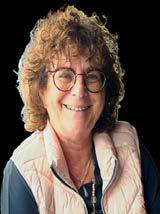
Feel free to send in any parenting
THIS WEEK: Urgent! Help to cover cost of examination for cancer prevention (NIS 8500) not covered by Misrad Habri'ut for a single woman recovering from physical abuse.
• Checks: Make out to “Yesh Ezra” Send to: Yesh Ezra, POB 31476, Romema, Jerusalem, 9136101



• Bank Transfer: Bank Mercantile (17), Branch 642, A/C 79747843, Yesh Ezra To obtain your tax benefit receipt, send details by Whatsapp/email.
• Credit card: Sara at 077-820-0196



Sunday, Monday, and Wednesday (10:15am - 2:45pm)
• Website: www.yeshezra.org Click on “Donate Now”
Inquiries: Menachem Persoff 050-570-1067

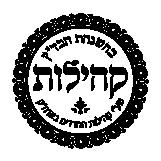





menpmp@gmail.com

OU ISRAEL CENTER 71
Twice asNice f or Half the Price! ™ motti@mrashkelon.com | www.mrashkelon.com 054 7312118 Our teamwork will make your dream work Your Licensed Real Estate Agents
Openning hours: Thursday 12 pm-2 am Friday 8 am-3 pm 02-9964469 | 054-8777347 Iben Shafrut 5, Rehavia, Jerusalem
Shabbos Bistro Premium delicious shabbes meals

72 TORAH TIDBITS 1514 / EMOR

OU ISRAEL CENTER 73
OU-JLIC
Rabbi Joe Wolfson
“And you shall not desecrate My holy name, and I will be sanctified amongst the children of Israel, I am Hashem who sanctifies you” (Vayikra 22:32).
What does it mean to desecrate or sanctify God’s name? A fascinating array of answers have been given,each of which explains the above verse in a different way.
The classical interpretation is that the verse speaks of extremes. Rashi explains the verse as relating to martyrdom – a directive for Jews to give up their life for the sake of their religion if forced to transgress it. Amongst the children of Israel – denotes that this is in an act of public significance – at a time of persecution, not of an individual, but of the people as a whole.
The Talmud Yoma 86a however has a very different take – the verse does not relate to a one-off extreme situation but rather to the everyday conduct of those who study and teach Torah and are associated with God’s name. When they conduct themselves pleasantly and with respect for others, then God’s name is sanctified. When they conduct themselves with arrogance and are untrustworthy, they desecrate His name.
In a secularized but related fashion, Israelis leaving the country at Ben Gurion airport are confronted with a sign, in Hebrew, which reads: Overseas: You Are The State!
Sanctification of God’s name is thus the requirement to ensure that Jewish religion, values and identity are not brought into disrepute through the behavior of those who represent them but rather are elevated through their conduct.
A final interpretation, that places the verse in its wider context, is that of Ibn Ezra. As Emor begins with Mosheh addressing the Priests, so this section concludes with this general commandment uniquely to them.
‘Amongst the children of Israel’ – by the priests within Israel.
Rabbi Joe Wolfson is the rabbi and co-director of JLIC TLV - a new vibrant community serving young religious olim in Tel Aviv, generously supported by the Mayberg Foundation. He and his wife Corinne both grew up in the UK and served as the directors of JLIC NYU in downtown Manhattan from 2015 to 2022

The OU’s Jewish Learning Initiative on Campus (JLIC) is creating and nurturing vibrant religious communities in Israel to support English-speaking college students and young professionals. JLIC Israel’s goals include: building a warm and welcoming Jewish community for students and young professionals; providing engaging and dynamic Jewish education; providing a supportive home environment for Olim; providing resources for personal and religious growth, including personal mentoring, Aliyah support, religious guidance and leadership development.
Current JLIC programs in Israel include: Reichman University - Herzliya; Bar Ilan University - Givat Shmuel; Tel Aviv University; Tel Aviv for Young Professionals; and Jerusalem. Contact: Rabbi Jonathan Shulman, Director of OU-JLIC in Israel shulmanj@ou.org

74 TORAH TIDBITS 1514 / EMOR
Orthodox Union Heshe and Harriet Seif Jewish Learning Initiative on Campus
המלש האופר
...
•Yosef Ezriel ben Chaya Michal
הלחמ ןב ןתנוהי •
רתסא ןב המלש •
• Esther Fruma bat Baila
• Yisrael Leib ben Chana
• Chana Bat Bruriah
• Chaim Moshe Ben Leah
Be’er Tziporah a"h - Bottled Water Gemach
Walking down King George St. in Jerusalem and want a cold bottle of water?
Come help yourself to a bottle at 52 King George.
In loving memory of Yoni’s wife Tziporah a"h, a true Eishes Chayil, always full of chessed, kindness and laughter, and brought life and strength to so many people, that she touched! She was like Aron, who loved peace and pursued peace. Yoni thanks Hashem for having the opportunity of having Tziporah in his life, to learn of her caring, patience and happiness, to overcome her challenges. May Tziporah's Neshama be a light onto the world, in a time of darkness, and may her Neshama shine to Gan Eden. Yoni misses Tziporah with tears in his eyes, as Hashem gave him a gift, a crown jewel, now he returns her to Hashem. With thanks and Toda. Love, Yoni
To help refill the supplysend tax deductible donations for Be’er Tziporah a"h

Bottled Water Gemach
to Chabad of RechaviaRabbi Yisroel Goldberg email
Rabbi@JerusalemChabad.org

02 800-1717
www.JerusalermChabad.org/DonateShekels
Real Life Rescues
Putting Torah Learning On Hold To Save A Life

Last Thursday just after 8:00 P.M., a man in his 80s suffered a cardiac arrest in the Misgav Ladach Hospital in Jerusalem. Because the hospital currently operates as a clinic and lacks the essential equipment and staff to handle such cases, the personnel promptly notified emergency services.
United Hatzalah volunteer EMT Matan Shnir was learning Torah with his two children in the hospital’s beit midrash when he received the call on his communications device. Realizing that the emergency was in the building, Matan apologized to his children and ran out of the beit midrash. The volunteer quickly located the room and assessed the situation, recognizing from the patient’s agonal breathing that he was suffering cardiac arrest.

The EMT promptly initiated CPR and instructed the personnel to begin chest compressions while he obtained one of the clinic's defibrillators and attached it to the man's chest. The group of medical practitioners continued to perform chest compressions and provide assisted ventilation to the patient for approximately five minutes until the defibrillator recommended administering a shock. Following the successful delivery of the shock, the man's pulse was restored. A sense of relief filled the room as an ambulance team arrived at the scene and transported the patient to the hospital for further treatment.
Matan later reflected on the incident and said: “Helping to save a life is always very rewarding. Even though the Torah learning with my children was interrupted, my children know that I often have to drop everything to save lives and I think it teaches them an important life lesson.”
OU ISRAEL CENTER 75
בוט יכ 'הל ודוה
1221
TORAH 4 TEENS
BY TEENS NCSY ISRAEL


 Rena Bessner
Rena Bessner

Jerusalem Chapter Director
It’s All In The Details
Currently, we are in the midst of Sfirat HaOmer; 49 days of counting up to the big day of Matan Torah. Usually, when we count, we find ourselves counting down toward something, but when it comes to Shavuot, we find ourselves counting up toward it. A reason for this can be found in the first Pasuk of this week’s Parsha.
... Hashem said to Moshe: Speak to the Kohanim, the sons of Aaron, and say to them... The obvious question is what is the reason for the use of the double language of Emor and Amarta, both indications of speaking? In Rashi’s explanation for this Pasuk, he says the extra term of speech is really just םיִלֹודְּג
. This is generally understood to mean that the Gdolim (older) Kohanim should pass on this message to the Ktanim (younger) Kohanim. However, Rabbi Gershon Turetsky understands this Rashi differently. He explains that what Rashi is saying is that no matter how Gadol (great) you are, the secret to greatness at the end of the day is in the Ktanim- the small things. If you want to become great, you have to pay attention to the specifics and all the small details. This is true for
all things, for example, imagine a painter forgetting all of the details when drawing. The painting would be anything but art!
The same concept can be applied to Sfirat HaOmer. Despite each day seeming rather small in the large scheme of things, it is better to understand them as essential details to the final product. Counting down towards Matan Torah would imply eliminating days or checking off boxes, so, rather by counting up toward the big day, the way we do, is to emphasize the importance of each small day in this greater process.
May we be Zocheh to continue to take advantage of these days to grow spiritually as Jews in preparation for Shavuot, and to not forget the importance of all the details.
Eli Dersovitz 12th Grade, Rechovot Practice Makes “Pure-fect”
Parshat Emor discusses the Mitzvah of celebrating the holidays, and all their technicalities. They are mentioned between the laws of purity for Kohanim and B’nei Yisrael, and the requirements of the דימת רנ, which is made of the finest oil, and brought on a pure Menorah. If the recurring theme here is purity, what is the purpose of the placement of the Chaggim here? The Zohar
76 TORAH TIDBITS 1514 / EMOR
ןֹרֲהַא יֵנְּב םי ִנֲהֹּכַה־לֶא ר ֹמֱא הֶׁשֹמ־לֶא קָוקְי רֶמא ֹּיַו םֶהֵלֲא ָּתְרַמָאְו
ריִהְזַהְל םיִּנַטְּקַה לַע
brings the idea of ןוילעה תבשו ןותחתה תבש- the lower and upper Shabbat-which can be related to the phrase “הבשחמב, השעמ ףוס הליחת”-



"First in thought and last in deed”.
The lower Shabbat represents the culmination of the completion of the physical universe which we commemorate through our observance of the weekly Shabbat. Yetziat Mitzrayim up until Matan Torah represents the upper Shabbat, when Hashem revealed his intention for all of creation by claiming us as his nation.
During these days of Sefirat HaOmer, we remember Hashem’s guidance in reaching the level of purity needed to receive the Torah. Perhaps the placement of the Chaggim in Parshat Emor isn’t so random after all. Celebrating the Chaggim helps us reach a spiritual level deserving of redemption. Just like B’nei Yisrael prepared themselves to receive the Torah, we are preparing every day for the Geula.


Sefirat HaOmer, which is required to be consistently counted, along with the רנ דימת , which must be constantly lit, teaches us that with consistent observance of the Mitzvot, we can achieve the level of purity Hashem desires in order to merit the ultimate Geula.
WITH
History
•
•
OU ISRAEL CENTER 77
053-‐427-‐6363 CINEMA
CITY
MALL,
JERUSALEM ArthurMSamuels@gmail.com PODIATRIST Over
30
years
experience Arthur
Samuels,
DPM Licensed in Israel & America CINEMA CITY MALL, JERUSALEM
Tour reservations must me made in advance and confirmed by text or email register online at ateretcohanim.org/tours In Israel call Daniel 054-654-4407 dljerusalem@gmail.com In US call Shani 917-297-2075 shaniateret@gmail.com scan here to reserve your tour Please
to keep All of Jerusalem United with Jewish Life ^ Our RESERVATIONS MUST BE MADE IN ADVANCE Tours are filling up fast! RESERVE NOW!
to
Jerusalem"
Take a Walk Through
TOUR THE OLD CITY
ATERET COHANIM
tour with us the next time you are in Israel, you will be amazed at what we are doing
Ateret Cohanim Tours Welcomes The World Orthodox Israel Congress and urges you
visit "Our
• Old City Tours
Shield of Jerusalem
4/30
5/3
dates
upon request
Yemenite Village Tours available for
&
other
available






78 TORAH TIDBITS 1514 / EMOR YOUR ALIYAH FLIGHT FACILITATE • CELEBRATE • ADVOCATE • EDUCATE WORKING IN PARTNERSHIP TO BUILD A STRONGER ISRAEL THROUGH ALIYAH Got Aliyah questions? We've got answers! *3680 answers@nbn.org.il

OU ISRAEL CENTER 79
JOIN US IN PAYING TRIBUTE TO THE LEGACY OF A FALLEN HERO OF ISRAEL.
MAKE A MEANINGFUL CONTRIBUTION BY DONATING TOWARDS AN AMBUCYCLE IN YONI JESNER’S MEMORY.


ALL DONORS WILL BE GIVEN AN OPPORTUNITY TO HELP NAME THIS AMBUCYCLE.
https://israelrescue.org/younameit
UNITED HATZALAH























































 BY RABBI DR. TZVI HERSH WEINREB OU Executive Vice President, Emeritus
BY RABBI DR. TZVI HERSH WEINREB OU Executive Vice President, Emeritus












































































































 RAV DANIEL MANN
RAV DANIEL MANN





 BY RABBI MOSHE BLOOM en.toraland.org.il
BY RABBI MOSHE BLOOM en.toraland.org.il






 BY JACOB SOLOMON Contributer, Torah Tidbits
BY JACOB SOLOMON Contributer, Torah Tidbits






























 Rena Bessner
Rena Bessner













